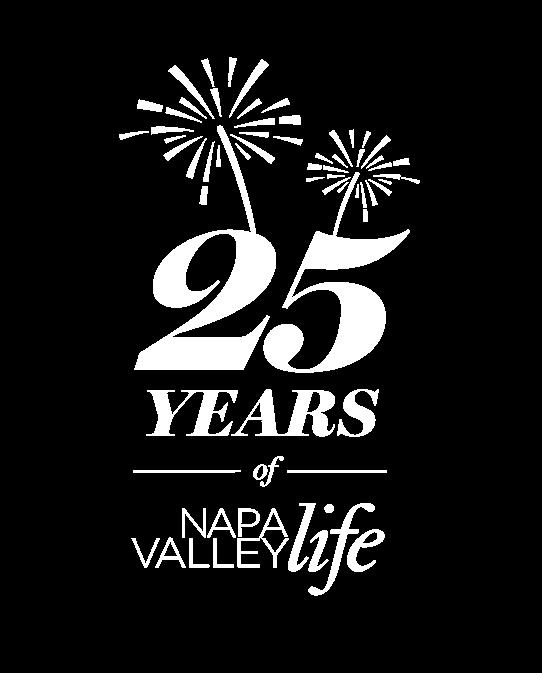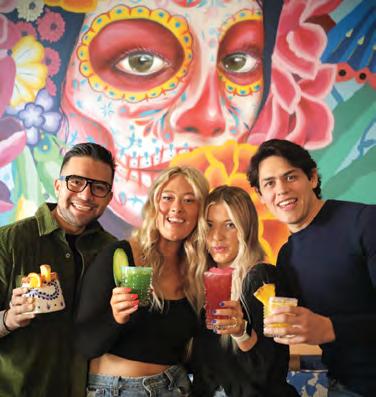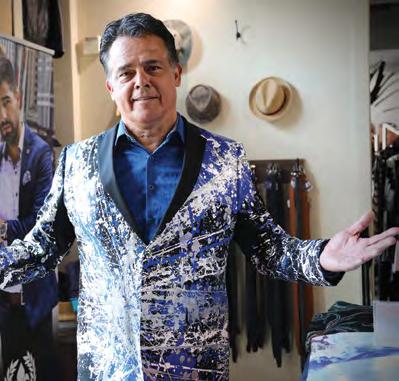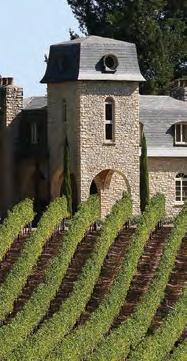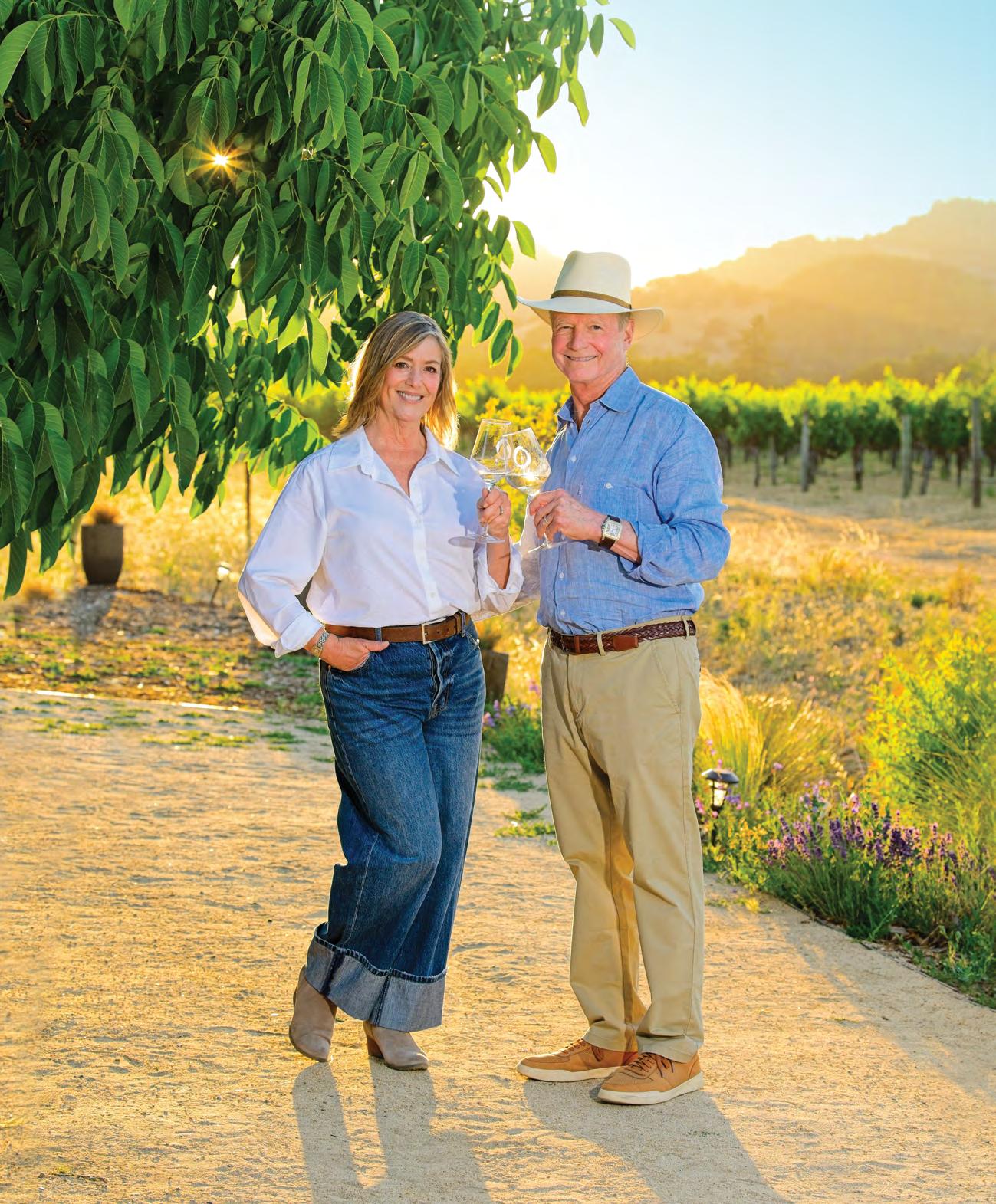






We’re bullish on your future. When we work together, you get personalized guidance, insights and financial planning — all designed to connect your life with your finances and to help make the path toward your goals even clearer.
Let’s have a conversation.
The Gonzales Group
Eric F. Gonzales
Merrill Lynch Wealth Management
Senior Vice President
Senior Resident Director-Wealth Management Advisor
707.254.4606
eric_gonzales@ml.com fa.ml.com/gonzales_group




works by both established masters and rising
In true Napa Valley style, guests can relax and enjoy a tasting of fine wines, making every visit a memorable, multi‑sensory experience. The gallery will soon launch the Glass Canvas Wine Club , offering members access to limited‑production wines inspired by the world of art, along with special invitations to private openings, tasting events, and other exclusive gatherings.



















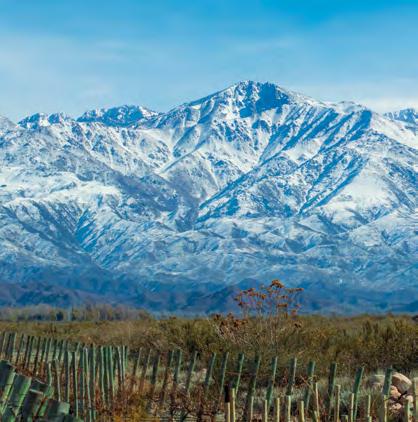







Everything beloved about The Watermark at Napa Valley has flourished into a higher level of distinguished living at the new Calligraphy Napa Valley.
With an enhanced focus on luxury hospitality services, Calligraphy elevates every moment with careful attention. Step into a world where bespoke experiences meet meaningful connections. Here, like minded people become neighbors and friends, care is as discreet as it is customized, and a fulfilling and dynamic life well lived is a privilege well earned. Come experience us for the first time or revisit us to see what your next chapter brings.

“A meal without wine is like a day without sunshine.”

August has arrived, and with it comes our annual Food & Wine edition—a celebration of Napa Valley’s rich culinary and wine culture. This special issue includes our signature Forks & Corks feature, highlighting some of the region’s most exceptional wineries and restaurants. You’ll also find a flavorful mix of stories, including a guide to discovering Napa’s finest cheeses along the California Cheese Trail, a deep dive into the fascinating history of Mission Wine, and an insider’s look at where Napa locals love to eat. It’s a delicious journey through the tastes and traditions that define the valley.
Our cover story spotlights one of Napa Valley’s most beloved wineries—O’Brien Estate. When Bart and Barb O’Brien arrived in Napa 25 years ago, they brought with them more than a dream—they had a vision rooted in romance, passion, and a sense of purpose. With the support of a few well-connected neighbors and the charm of heartfelt love poems, they transformed that vision into a thriving estate. Today, O’Brien Estate is known not only for its award-winning wines but for the unforgettable story behind every bottle—a tale of love, legacy, and the magic that happens when dreams take root in Napa soil.
When it comes to Napa Valley, few places capture the spirit of great wine quite like Oakville, our featured AVA story. Tucked between the Mayacamas and Vaca Mountains, this sunny little stretch has earned a big reputation for producing some of the valley’s best Cabernet Sauvignon— wines that are rich, smooth, and full of character. Oakville is where long-time family estates and trailblazing winemakers come together, and where the vineyards are just as famous as the wines they produce. It’s the heart of Napa’s Cabernet scene—and a must-visit for anyone who loves a good glass of red.
Our Wine Region story showcases Mendoza, renowned for its powerful Malbecs and flame-kissed beef, all set against the backdrop of the Andes. While this timeless combination remains the heart of the region, something extraordinary is happening in Argentina’s wine capital. Today’s Mendoza pulses with creative energy as talented winemakers experiment with high-altitude vineyards, celebrated chefs reimagine traditional flavors, and master distillers craft spirits that capture the soul of the mountains, fearlessly pushing boundaries, proving that the most authentic expressions often come from blending deep roots with bold vision.
From world-class vintages to extraordinary culinary adventures, Napa Valley offers discoveries around every corner. Whether you’re a seasoned connoisseur or an enthusiastic newcomer ready to explore, Napa Valley promises an abundance of award-winning wines and exceptional menus that consistently deliver unforgettable experiences, leaving you asking for more.
Bon Appetit!

Laura Larson Editor




Visit Napa Valley welcomes you to explore the food, wine and people that make this region one of a kind. From open kitchens to tucked-away tasting rooms, every experience reflects the valley’s love for craft and connection. Your visit means more than just a meal or a glass of wine; it helps local chefs, winemakers, and hospitality teams keep doing what they love. Come sip, savor, and experience Napa Valley. Cheers, The Good Life.

CHIEF EXECUTIVE OFFICER
Derek Wright
PRESIDENT Kevin Evans
VICE PRESIDENT OF OPERATIONS
Nicole Branning
EDITOR
Laura Larson
CREATIVE DIRECTOR
Erin Hayden Seal
ADVERTISING SALES
Doris Hobbs doris.hobbs@napavalleylife.com
CONTRIBUTING WRITERS
Fran Miller
Layne Randolph
Jillian Dara
Melissa Vogt
Laurie Jo Miller Farr
CONTRIBUTING PHOTOGRAPHERS
Art & Clarity – Lowell Downey
ABOUT THE COVER
Barb and Bart O'Brien at their family
winery, O'Brien Estate

Corporate Headquarters: 314 E. Highland Mall Blvd., Suite 125, Austin, TX 78752
/NVLife @napavalleylifemag


# PHOTOS BY DARBY
JOHNSON AND TEAM
On Saturday, May 17, more than 400 guests gathered for the Neighborhood Table, a beloved Napa Valley tradition hosted by the St. Helena Hospital Foundation under the leadership of President & CEO Glen Newhart. Held on Adams Street in downtown St. Helena, the evening featured great food by Chef Nash Cognetti at Tre Posti, live music by Apple Z, and strong community spirit supporting local health initiatives. Proceeds benefited the Foundation’s Mobile Health team, “Mobi,” which brings essential healthcare services directly to Napa Valley’s most vulnerable residents. Each event ticket also helped provide 250 pounds of fresh produce to local families facing food insecurity. This year’s gathering honored the legacy of Elaine M. Jones, Neighborhood Table founder and former board member, whose vision has helped raise nearly $1 million for community health since 2019. // www.shhfoundation.org/special-events/neighborhood-table-2025/


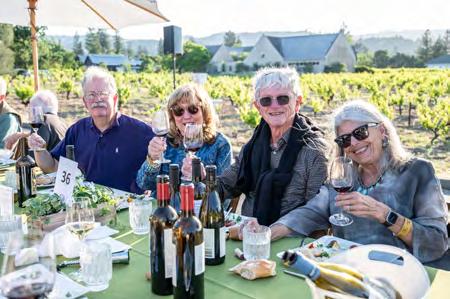

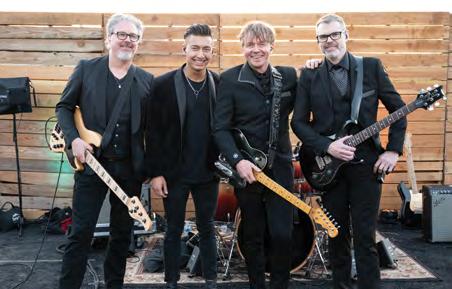


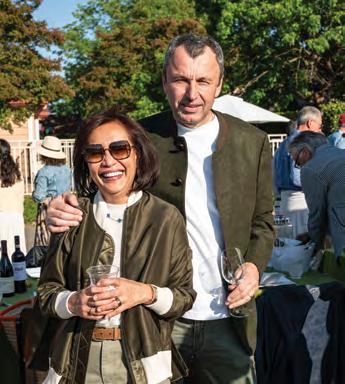


# PHOTOS COURTESY OF BOTTLEROCK NAPA VALLEY (unless otherwise noted)
Back for its 12th Season, BottleRock Napa Valley, presented by JaM Cellars, was back in full force at the Napa Valley Expo over the Memorial Day weekend (May 23-25). In addition to headliners Green Day, Justin Timberlake, and Noah Kahan, the festival lineup included nearly 80 musical acts, including Benson Boone, Khruangbin, Cage the Elephant, Ice Cube, Sublime, Kaskade, Rebelution, Carín León, Goose, SOFI TUKKER, and Public Enemy to name a few. The Culinary Stage delighted fans with culinary stars Bobby Flay, Trisha Yearwood, Kristin Kish, and Masaharu Morimoto, along with sports legends Serena Williams and Ken Griffey Jr., and actor/producer Adam Devine to headline alongside dozens of additional chefs, musicians, sports and screen stars. The 3-day music, wine, craft brew, and culinary festival is one of the most enjoyable festivals in the US, attracting over 120,000 attendees. // www.bottlerocknapavalley.com





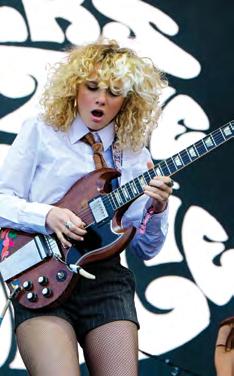



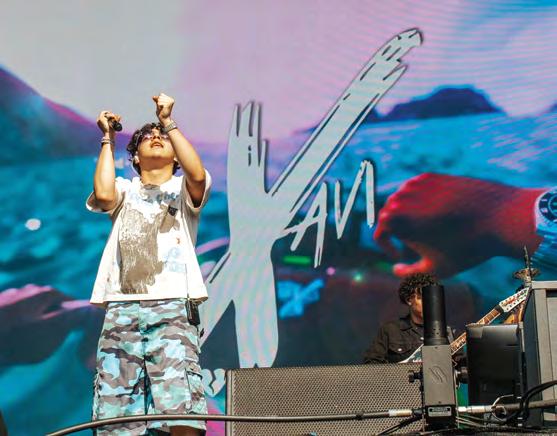
# PHOTOS COURTESY OF LA ONDA FESTIVAL (unless otherwise noted)
The 2nd Annual La Onda festival, produced by the team that brings BottleRock Napa Valley to town, was held May 31 and June 1st at the Napa Valley Expo and was great success. Fans cheered on Latin music stars including Marco Antonio Solis, Banda MS, Carin León, Tito Double P, Pepe Aguilar, Eden Muñoz and dozens more, enjoyed the best Latin inspired food and beverages, and witnessed entertaining Lucha Libre matches all weekend long under sunny skies. La Onda will return May 30 & 31, 2026. // www.laondafest.com











# PHOTOS BY CHESTER COOLEY PHOTOGRAPHY
This year’s Auction Napa Valley was another huge success, raising $6.5 million to benefit Napa Valley Vintners’ Youth Wellness Initiative. This year marks 45 years of giving by Napa Valley Vintners, whose deep investments in the community continue to make a lasting impact. Attended by nearly 2,000 and co-chaired by Alpha-Omega owners Robin and Michelle Baggett, the event highlighted the shared spirit and generosity of Napa Valley. Online bidding opened Tuesday, June 3, and the Auction weekend kicked off with the barrel auction at Louis B. Martini Winery and Saturday’s live auction at Chandon. The top five lots were experiences curated by Antinori Napa Valley and Stag’s Leap Wine Cellars, Alpha Omega and Bouchaine Vineyards, St. Supéry Estate Vineyards & Winery and CHANEL, Darioush and The World, and Kenzo Estate. // www.napavintners.com




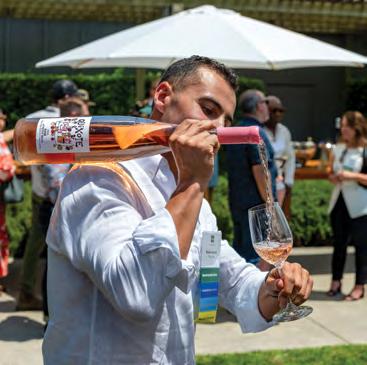


# PHOTOS BY
DARBY JOHNSON AND TEAM

Hosted by Lauren Dickson and Elyse Walker at a private estate on May 31, the sold-out Runway for Red luncheon united 150 women for an unforgettable afternoon of fashion, philanthropy, and purpose—raising $1.2 million to support a new Cardiac Center of Excellence at St. Helena Hospital. Guests enjoyed a curated runway show by Elyse Walker, a seasonal menu by La Saison, florals by Miss Dee Designs, and wines from Frank Family Vineyards—joined by contributions from fellow board members and friends of the hospital. A lively auction led by Leslie Frank and Glen Newhart, President and CEO of the St. Helena Hospital Foundation, added to the impact. Special guests included Gina Gallo and Julie Vanderwall, Maria Torres, Alicia Vanderbyl, Leslie Frank, Nicole and Brianna Garcia (The Bella Twins), Mary Cunningham Agee, Marta Dalla Gasperina and Gigi Harlan, Nina Rotello, Donna Walker, Anne Cottrell, and more. With 100% proceeds going directly to heart care, Runway for Red was a powerful celebration of community, resilience, and hope. // www.shhfoundation.org
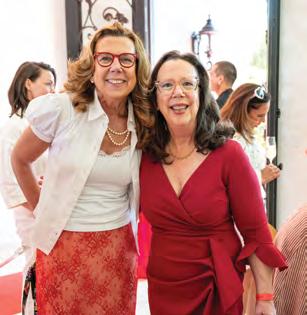




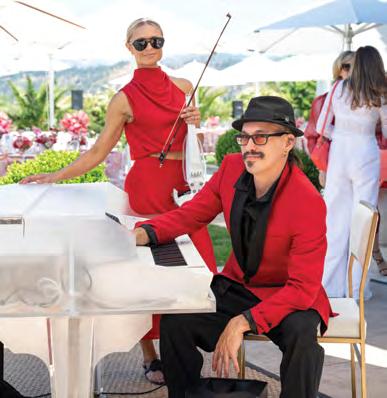




Event dates subject to change. Please check event websites for current schedules.

August 7–10
The annual Napa Town & Country Fair is back at the Napa Valley Expo Center from Aug. 7-10. The annual fair features a carnival with rides, art installations, a wine lounge, agricultural and livestock exhibits, fun fair food, live music from Chase Matthew, Revisiting Creedence, Banda Carnival, and the Ying Yang Twins. Ticket prices range. On opening day, Thursday, tickets are free for youth, seniors, and active military personnel. www.napafair.org
August 24
A Culinary Adventure for Pups and Their People, Waggin’ Trails Rescue Foundation will host an afternoon of food, wine, music, and furry friends at The Meritage Resort on Sunday, Aug. 24, from 1 to 5pm. This pet-friendly celebration supports its mission to give rescue dogs a second chance at life. Enjoy VIP experiences, local wine tastings, and culinary delights while supporting a great cause. Tickets are $125 www.waggintrailsrescue.com/events

August 29–31
Blue Note Jazz Festival is back in collaboration with Artist in Residence Robert Glasper for the Black Radio Experience at the Meritage Resort & Spa. The three-day event will feature jazz, hip-hop, R&B, soul, spoken word, and live DJ sets, celebrating the sound, legacy, and future of music in all its forms. Along with over 15 musical acts, headliners include Jazmine Sullivan, The Roots, and Earth, Wind & Fire, and special guests Questlove, Yebba, and Slum Village. www.bluenotejazz.com
September 11–14
Set against the backdrop of Napa Valley’s world-renowned wine country, the Procore Championship returns this fall with the perfect blend of PGA TOUR action and luxury experiences. Hosted at the Silverado Resort featuring 144 PGA players, fans can enjoy world-class golf, premier Napa wines, top-shelf libations, and indulgent bites under the shade of oak-lined fairways. On-course venues include the Meiomi Wine Terrace, overlooking the 17th green, and the Visit
Napa Valley Fan Village, located near the 18th fairway, where fans can unwind with local varietals, premium concessions, and a large LED screen. Fans seeking an enhanced experience can elevate their day at the all-new Redwood Club, a VIP shared hospitality venue. Ticket prices range from $55- $250 per day. www.procurechampionship.com
Back for its 31st year, the One Mind Music Festival returns on Saturday, September 13, 2025, at the Staglin Family Vineyard in Rutherford. Guests will be treated to an inspiring day of transformative science, innovation, music, and wine. Ticketholders support One Mind’s mission to advance brain health research and make a lasting impact on those affected by mental health challenges. This year’s festival features a Science and Innovation Symposium followed by a wine and food tasting, featuring some of Napa’s most premier wines and bites prepared by Dustin Valette. The afternoon will wrap with a performance by the multi-Grammy award-winning band, Train. www.music-festival.org
September 13 HANDS ACROSS THE VALLEY
Hands Across the Valley is back for its 33rd year on Saturday, September 13th, from 5 to 10pm at the historic Charles Krug Winery in St. Helena. Guests get to indulge in some of Napa’s best food and wine featuring the area’s most renowned restaurants and wineries while perusing the many silent auction lots up for bidding. Stick around for dancing to live music under the stars. Hands Across The Valley raises monies specifically for the safety net food programs in Napa County – including The Food Bank, Meals on Wheels, and other vital programs that serve those in need, from American Canyon to Calistoga. www.handsacrossthevalley.com
September 20–21 and 27–28
Attention Art Lovers! Napa Valley’s annual Open Studios weekends are back, where local artists open their studios to showcase their work. Attendees are invited to join a self-guided art discovery tour through the creative art spaces of Napa Valley. Jessel Gallery will host a preview from September 1 to 30, with a reception on Friday, September 6, from 5 to 8pm. Artists will be present. 1019 Atlas Peak Road, Napa. www.artnv.org/open-studios-home/
28
Pending approval from the City of Saint Helena, from 12:30 to 5pm, the streets of Saint Helena will come alive for the first annual Saint Helena Porchfest—a vibrant, walkable music celebration like no other. Local porches throughout town will transform into intimate concert stages, featuring an eclectic lineup of musicians from around the Napa Valley and beyond. Whether strolling with friends, bringing the family, or just soaking in the vibe, attendees will enjoy an afternoon filled with live performances, community spirit, and small-town charm. Grab a map, wander from porch to porch, and discover the hidden musical gems of the community in a setting that’s warm, welcoming, and uniquely Saint Helena. www.sainthelenaporchfest.com
Locals-favorite, Heritage Eats, recently switched to a fullservice restaurant with a new name, a modest redesign, an updated menu, and a bar serving beer and wine on tap. The concept is family and big group-friendly with booths, tabletop games, and two TVs that play sporting events. Along with its popular international menu, new items such as Benny’s Double Smash Burger, delicious sandwiches and salads, and seasonal items like Lobster Rolls and brunch on weekends have been added. Happy hours will be hosted Mon-Fri from 6–9pm. Open daily, 11am–9pm. //
3824 BEL AIRE PLAZA, NAPA • WWW.HERITAGEEATS.COM
Join the fun on Friday evenings when Lucito Alamaras hosts live karaoke in the Trancas Steakhouse bar and lounge. The mic gets turned on from 8:30pm to midnight when potential divas and rock stars croon to a broad mix of popular tunes. Great for soloists or groups. For performers and audience members, a full bar is available, along with nine types of beer on tap. // 999 TRANCAS ST., N. NAPA WWW.TRANCASSTEAKHOUSE.COM
Mary’s Pizza Shack is a great place for locals. Besides a great selection of pizza, pasta, salads, and sandwiches, they offer free corkage to locals on the first bottle of wine and only charge $10 for the second. Stop by for Happy Hour from 3-5pm Monday–Friday and get ½ price appetizers and $2 off a glass of wine. // 3085 JEFFERSON ST., NAPA WWW.MARYSPIZZASHACK.COM
Come downtown on the third Wednesday of the month from 5-7pm, and for $10, get a glass and a wristband and enjoy specials from participating shops and tasting rooms. Each night, a different downtown district is featured, with the intention of showcasing stores and establishments that guests may not have visited before. Strollers also get to enjoy live, outdoor music while they’re shopping and sipping. // WWW.DONAPA.COM
Embrace the vinyl renaissance at the Carneros Resort FARM Pavilion on the last Friday of each month. Listening to records spun by local DJ Rotten Robbie, sipping wine by the glass provided by a rotating list of Napa and Sonoma wineries, and enjoying small bites offers a perfect soundtrack for an unforgettable night in Napa. This is the ultimate way to unwind and savor a Napa summer night, set in the al fresco lounge with fire pits, cozy seating, and lush culinary gardens. 5pm–12am through September. // 4048 SONOMA HWY., NAPA
WWW.FARMATCARNEROS.COM/EVENT/VINYL-WINE/






BY LAURA LARSON
Napa Valley is where every moment feels like a celebration of life’s finest pleasures. From world-renowned wineries and breathtaking vineyard views to luxurious spas, charming small towns, and unforgettable culinary adventures, Napa offers something for everyone. In the spirit of our 25th Anniversary year, we’ve curated a list of 25 must-do experiences that capture the magic of Napa wine country. Whether a firsttime visitor or a seasoned local, these bucket list adventures will help anyone savor the best of Napa Valley—and create memories that will last a lifetime.

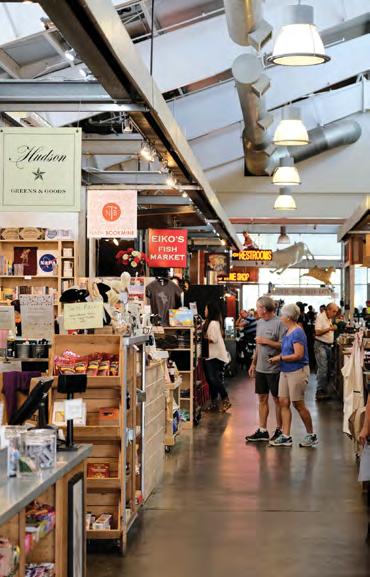
Oxbow Public Market is a bustling 40,000-square-foot hub for food lovers and wine enthusiasts. Located in downtown Napa overlooking the Napa River, it offers a diverse mix of local vendors, a wide selection of artisan eateries, and specialty shops where one can enjoy a fresh ground espresso from Ritual Coffee, savor oysters from Hog Island Oyster Co., or indulge in fresh pastries from Model Bakery. The market also hosts live music, wine and olive oil tastings, and cooking demos, making it a must-visit destination for a taste of Napa Valley’s culinary scene.
610 FIRST ST., NAPA
WWW.OXBOWPUBLICMARKET.COM

The Uptown Theatre is a beautifully restored Art Deco venue that first opened in downtown Napa in 1937. With a seating capacity of 863, it offers an intimate setting where every seat is within 90 feet of the stage, ensuring excellent views and acoustics. The theater hosts a variety of performances, including music and comedy acts, featuring renowned artists such as Willie Nelson and B.B. King. Its historic charm and eclectic mix of artists and entertainment options make it a must-visit destination in downtown Napa.
1350 THIRD ST., NAPA WWW.UPTOWNTHEATRENAPA.COM

The Napa Valley Museum offers a rich cultural experience that delves into the region’s art, history, and environment. Now, with two locations—Napa Valley Museum Yountville and the new MAC (Museum of Art & Culture)—the museum presents a diverse range of exhibitions, from historical artifacts to contemporary art. Interactive displays and educational programs make it engaging for all ages, providing a deeper understanding of Napa Valley’s unique heritage. It’s a must-visit for those seeking to enrich their wine country experience with cultural insights.
55 PRESIDENT'S CIRCLE, YOUNTVILLE
607 ST. HELENA HWY., ST. HELENA WWW. NAPAVALLEYMUSEUM.ORG
WWW.VINETRAIL.ORG 4

Cycling the Napa Valley Vine Trail offers an immersive journey through wine country. The 47-mile paved path stretches from Vallejo to Calistoga, weaving past vineyards and several towns, such as Napa, Yountville, and St. Helena. The trail offers a safe, car-free route for cyclists of all levels, with amenities such as rest stops and art installations enhancing the experience along the way. Recent expansions, including the scenic Calistoga to St. Helena segment, make it an ideal way to explore Napa’s landscape and culture on two wheels.

Soar above Napa Valley’s rolling vineyards with a sunrise hot air balloon ride—an unforgettable way to experience wine country from the sky. Most companies offer pricing packages for singles or groups, and some even include early morning flights, complete with pre-flight pastries and post-flight sparkling wine toasts.

Experience the art of winemaking firsthand with one of Napa’s premier wineries. Raymond Vineyards and Conn Creek Winery are two Napa Valley wineries that offer a “Winemaker for a Day” program, which invites guests into their blending rooms for a unique, hands-on winemaking experience. Participants craft their own red blends, bottle them, design a custom label, and take home their personalized creations.
WWW.RAYMONDVINEYARDS.COM • WWW.CONNCREEK.COM


Attending a Barrel Auction in Napa Valley offers wine lovers a rare, insider experience. Guests can taste exclusive, one-of-a-kind wines directly from the barrel, often limited-release or never-before-released vintages. It’s a chance to meet winemakers, learn about their craft, and bid on futures of highly sought-after wines. The festive atmosphere includes gourmet food, live music, and scenic vineyard settings, creating an unforgettable day in wine country. For collectors and enthusiasts, it’s not just about wine—it’s about access, discovery, and supporting local vintners. Events like Premiere Napa Valley and Auction Napa Valley, both hosted by Napa Valley Vintners, draw serious buyers and passionate fans alike.
WWW.NAPAVINTNERS.COM

Glide through the heart of Napa Valley on an authentic Venetian gondola with Napa Valley Gondola. Departing from downtown Napa’s Main Street riverfront, these private cruises offer a serene journey along the Napa River, complete with Italian melodies and a singing gondolier. Each handcrafted gondola accommodates up to six guests, perfect for romantic outings or small groups. Bring a favorite wine to enhance the experience.
WWW.NAPAVALLEYGONDOLA.COM
Relax and heal in one of Calistoga’s famed mud baths. Calistoga’s springs are best known for their volcanic ash, which is said to detoxify and soothe. Top spots include Indian Springs Resort, which offers classic mud and mineral water soaks, and the Roman Spa Hot Springs Resort, ideal for couples and those seeking spa packages. Dr. Wilkinson’s Backyard Resort & Mineral Springs combines retro charm with modern amenities. These spas offer clay-rich treatments, hydrotherapy, and massage, creating an indulgent and therapeutic experience set amidst wine country surroundings.
WWW.INDIANSPRINGSCALISTOGA.COM
WWW.ROMANSPAHOTSPRINGS.COM
WWW.DRWILKINSON.COM
Napa Valley offers a variety of cooking classes that cater to both culinary enthusiasts and professionals. The Culinary Institute of America at Copia in downtown Napa provides hands-on classes, including multi-day boot camps and single-day sessions, led by expert CIA chefs in a state-of-the-art facility. For a casual experience, PLAYTE Kitchen in Napa offers interactive classes such as “Takeout at Home” and “Foodie FUNdamentals,” which focus on diverse cuisines and techniques. Napa winery Cakebread Cellars, located in Rutherford, combines wine tasting with cooking classes, offering guests the opportunity to learn about food and wine pairings.

Booking a trip on the Napa Valley Wine Train offers a unique blend of luxury, history, and culinary adventure. Traveling in restored early 20th-century Pullman cars, guests can enjoy a series of experiences, including a 36-mile roundtrip journey from Napa to St. Helena. Foodies can indulge in gourmet multi-course meals crafted with fresh, local ingredients, complemented by Napa Valley wines. The train offers various curated experiences, including winery tours and tastings at local vineyards like Grgich Hills Estate and V. Sattui Winery. Whether a wine enthusiast or seeking a memorable culinary adventure, the Napa Valley Wine Train promises a memorable experience that captures the essence of Napa Valley’s heritage and hospitality.
WWW.WINETRAIN.COM

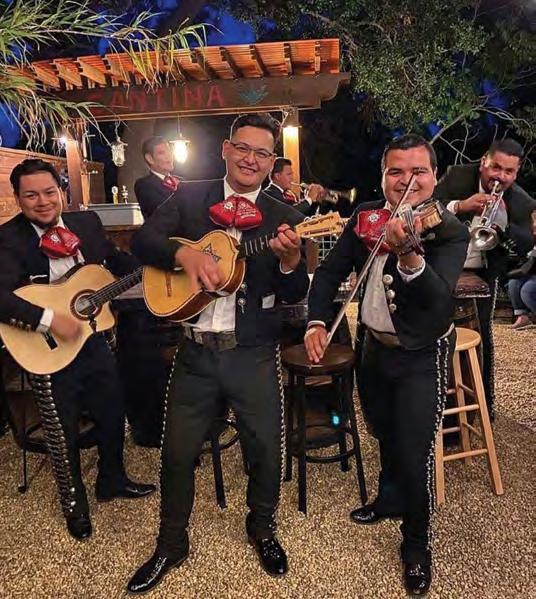
Celebrate the rich cultural heritage of Napa and check out a live mariachi show. A highlight is the annual ¡Viva Mariachi! Festival at Napa Valley College, held in April at the Performing Arts Center. This event features performances by esteemed groups like Mariachi Luz de Oro and Mariachi Aztlán, complemented by folklórico dance and local cuisine. Another notable event is La Onda, a Latin music festival at the Napa Valley Expo in late May. Alongside major headliners, attendees can enjoy roaming mariachi bands, Latin cuisine, and cultural festivities. For a more casual setting, Taqueria Maria in downtown Napa hosts live mariachi music on Friday evenings, and La Cheve Bakery and Brews occasionally features live mariachi performances on Sundays.
WWW.NAPAVALLEY.EDU • WWW.LAONDAFEST.COM
WWW.TAQUERIAMARIA.COM • WWW.ILOVELACHEVE.COM

The Rail Arts District (RAD) is an exciting, open-air gallery experience that both art enthusiasts and casual visitors will appreciate. Stretching two miles along the Napa Valley Vine Trail and the Napa Valley Wine Train tracks, RAD features an array of large-scale murals, sculptures, and installations by both local and international artists. Notable works include Felipe Pantone’s dynamic Chromadynamica, Hueman’s The Garden, and Mikey Kelley’s expansive Begin and Continue mural. RAD can be explored on foot or by bike. For more information and an interactive map, visit their website.
WWW.RADNAPA.ORG


For an invigorating outdoor adventure, the Oat Hill Mine Trail is a popular hiking trail known for its challenging terrain and rewarding views. It’s an 8-mile out-and-back trail that climbs to the top of Bald Hill, offering breathtaking views of Napa Valley. The trail is suitable for hikers, mountain bikers, and equestrians; however, prepare for a rough and rocky experience. It’s worth the effort once one reaches its peak and takes in the sweeping vistas of Napa Valley, Mount St. Helena, and the surrounding mountain ranges.
WWW.NAPAOUTDOORS.ORG/PARKS/OAT-HILL-MINE-TRAIL/

BottleRock Napa Valley is a must-attend event for music lovers and foodies. Set in the heart of downtown Napa, the three-day festival offers world-class musical performances alongside gourmet food, craft cocktails, and premium Napa wines. The diverse program and laid-back atmosphere are perfect for all ages. In addition to unforgettable headliners and musical acts, the event features celebrity chefs, culinary stages, and some of the best Napa “street food” from the region’s top chefs and restaurants. For anyone craving great music, exceptional food and wine, and scenic beauty, BottleRock is a bucket-list-worthy celebration.
WWW.BOTTLEROCKNAPAVALLEY.COM
Mustard season in Napa Valley, typically from late January to March, transforms the vineyards into a sea of yellow, perfect for unforgettable selfies. The golden fields beckon viewers to take photos with (or in) the mustard as a stunning backdrop. Whether snapping pics along the Silverado Trail or posing between vineyard rows, the scenery is Insta-magic. To find the best viewing spots, get the map from the Visit Napa Valley website.
WWW.VISITNAPAVALLEY.COM/EVENTS/WILD-MUSTARD-SEASON/ #MUSTARD-SEASON-MAP
Interested in exploring a hidden talent? Napa Valley has a fantastic art scene and offers diverse classes that cater to various skill levels and artistic interests. Jessel Miller of Jessel Gallery provides personalized painting classes suitable for all levels. Students benefit from individualized instruction and leave with a completed artwork. Classes are held on-site, with all materials provided. Some classes also include refreshments or potlucks. St. Helena’s Nimbus Arts is a community-focused nonprofit offering a wide range of classes, including painting, ceramics, and mixed media. Nimbus Arts hosts workshops for both adults and children, fostering creativity in a collaborative environment.
WWW.JESSELGALLERY.COM • WWW.NIMBUSARTS.ORG

Experience the natural wonder of Calistoga’s Old Faithful Geyser, one of only three “faithful” geysers in the world, erupting every 30–40 minutes. This family-friendly attraction offers more than just geothermal displays. Enjoy the petting zoo with fainting goats and llamas, explore serene gardens, and visit the geology museum. It’s also a perfect spot for a picnic!
WWW.OLDFAITHFULGEYSER.COM


The 1881 Napa Wine History Museum in Oakville offers a fascinating journey into the roots of Napa Valley’s winemaking legacy. Housed in one of the valley’s oldest Victorian homes, the museum showcases a rich collection of 19th-century winemaking artifacts, vintage tools, and historical photographs, providing insight into the pioneers who shaped the region’s viticultural heritage. This unique destination, brought to Napa by industry veteran, historian, and Napa icon Jean-Charles Boisset, is a must-visit for history enthusiasts and wine lovers.
WWW.MCSTAGING.1881NAPA.COM/WINE-HISTORY-MUSEUM

The Sterling Aerial Gondola at Sterling Vineyards is a one-of-a-kind journey to the only winery in the world with its own aerial gondola. Suspended up to 105 feet above the valley floor, the ride provides 360-degree views of Napa Valley through cabins featuring full-length panoramic windows. The solar-powered gondola provides a smooth ascent to the hilltop winery, where guests can enjoy tastings and take in the scenic vistas. The gondola’s unique triangular route offers a secluded and intimate experience, making it a must-do for anyone seeking a unique wine-country adventure.
WWW.STERLINGVINEYARDS.COM


Plan ahead and book a table at The French Laundry. A reservation at the prestigious three-Michelin-star restaurant in Napa Valley promises an unforgettable culinary journey hosted by Chef Thomas Keller and his staff. The daily-changing tasting menu showcases seasonal ingredients (some harvested from the restaurant garden) with French precision and creativity. Each course is a beautifully plated, flavor-packed experience paired with impeccable service and an extensive wine list. With flawless attention to detail and world-class execution, a meal at The French Laundry is a rare and exquisite celebration that is not to be missed.
WWW.THOMASKELLER.COM/TFL/

Get a glimpse of Napa Valley’s wine history by visiting its oldest winery. Established in 1861, Charles Krug is a cornerstone of California winemaking. It introduced the state’s first public tasting room in 1882, revolutionizing wine tourism. Owned by the Mondavi family since 1943, the estate blends historic charm with modern elegance, featuring the renovated Redwood Cellar and Carriage House. Visitors can enjoy acclaimed wines, including Cabernet Sauvignon and Bordeaux-style blends, in a setting rich with heritage and innovation. A visit offers a unique glimpse into Napa’s pioneering wine legacy.
2800 MAIN ST., ST. HELENA • WWW.CHARLESKRUG.COM

Visit one of Napa’s bustling farmers’ markets, each showcasing Napa’s best local offerings for meeting friends, greeting neighbors, and enjoying fresh produce, gourmet food vendors, and beautiful, handcrafted items. The three main markets are hosted in downtown Napa on Saturday mornings (year-round) and on Tuesdays (spring/summer season), in St. Helena on Friday mornings, and in Calistoga on Saturday mornings. Whether shopping for home-grown goods to prepare at home or homemade treats to enjoy at the market, there’s something for everyone.
WWW.NAPAFARMERSMARKET.ORG • WWW.STHELENAFARMERSMKT.ORG
WWW.VISITCALISTOGA.COM/LISTING/CALISTOGA-FARMERS-MARKET/
Harvest season in Napa Valley is an exciting time of the year, offering unique ways to participate. Many wineries invite guests to participate in hands-on experiences, such as grape picking, stomping, and behind-the-scenes tours of the crush pad and cellar. Grgich Hills Estate offers its famous grape stomp, and some wineries like Conn Creek Winery and Raymond Vineyards invite guests to try their hand at blending. Numerous harvest parties feature live music, local food, and fresh wine straight from the barrel. Vineyard walks and educational tastings provide insight into the winemaking process, and some wineries invite guests to experience their “Blessing of the Grapes” celebrations. During August –October, check out local events sites to plan a harvest experience.
WWW.NAPAVALLEYLIFE.COM/EVENTS • WWW.VISITNAPAVALLEY.COM

Bouchaine Vineyards in Napa Valley offers a unique falconry experience that combines wine tasting with an up-close encounter with birds of prey. Led by master falconer Rebecca Rosen, guests learn how falcons and hawks help protect the vineyards from grape-eating birds. The experience includes live flight demonstrations, opportunities to interact with the birds, and insights into sustainable farming practices. Afterward, guests can enjoy a glass of Bouchaine wine in the garden, with the option to bring a picnic.
WWW.BOUCHAINE.COM


The beloved San Francisco Italian restaurant A16 has officially opened in Napa Valley. Co-founded by Shelley Lindgren and Kitty Oestlien, A16 Napa specializes in Southern Italian food and wine. Housed in the redesigned former Miminashi space, the menu highlights Neapolitan-style pizzas, handmade pastas, and woodfired specialties. Signature dishes include pancetta-wrapped pork rolls, hearthcooked octopus, King Trumpet mushrooms and cavatelli with ragu bianco, and seasonal desserts like lemon verbena panna cotta and Hudson Ranch olive oil cake. The wine list focuses on Italian and California selections, including a special lineup of Tansy wines — a collaboration between Lindgren and Oestlien — alongside some rare finds. Open Mon-Sun from 5–9pm.
FOR MORE INFORMATION: 821 Coombs St., Napa // www.a16pizza.com

After years of building a devoted following through unforgettable pop-ups, private dinners, and elevated catering experiences, Carabao is proud to announce the opening of its first permanent location. Known for bold, soulful flavors and an unwavering sense of hospitality, Carabao’s Filipino menu has become a standout in the region’s evolving culinary scene. Led by Chef Jade Cunningham, in partnership with her husband, Mathew Cunningham, and Eric and Amaparo Gonzales, the eatery celebrates the flavors, stories, culture, and community of the Filipino people—and brings the rich flavors of Filipino cuisine to Napa Valley. Open Tues-Sat 5–9pm.
FOR MORE INFORMATION: 145C Gasser Dr., Napa // www.carabao-napa.com
Attention, pinball wizards! New to the Franklin Street alleyway, Marquee Pinball Lounge offers an engaging and interactive environment centered around the timeless appeal of pinball and classic arcade games. The lounge provides affordable entertainment & beverages for all ages and interests. With a range of collector limited edition pinball machines from Stern & Jersey Jack to the retro corner featuring Pulp Fiction & Big Lebowski (rug included), Marquee is designed to maximize friendly competition, featuring an open layout that encourages mingling, a comfortable seating area for spectators, and the potential for organized leagues and tournaments. The calendar includes Tuesday tournament nights, Weds Locals Night (unlimited play for 2 hours), and Launch Parties when new pinball machines arrive. Open Mon-Thu 3–10pm, Fri-Sat 12pm–12am and Sun 12–10pm.
FOR MORE INFORMATION: 1131 First Street, Napa www.marqueepinball.com





Epicurean veterans behind the Michelin-starred PRESS Restaurant (Samantha Rudd, Chef Philip Tessier, and Justin Williams) opened the much-anticipated culinary marketplace and café, Under-Study behind the new Napa Valley Museum of Art & Culture in St. Helena. More than just a restaurant, Under-Study is an evolving culinary concept serving breakfast, lunch, and happy hour with a wide selection of ingredients to take home, representing the best purveyors, traditions, and techniques while spotlighting the craftsmanship behind each dish. The robust menu includes popular items such as PRESS’s beloved Bacon Sampler, Bottle Rock’s famous Lobster Corn Dog, and delectable pastries created by Executive Pastry Chef Frank Vollkommer and Head Baker Domenic Reyes. The café has a butcher counter and fresh seafood and also serves coffee, tea, tap beers, cocktails, and a rotating selection of more than 80 wines. Open daily from 7am–5pm.
FOR MORE INFORMATION: 595 St. Helena Highway, St. Helena // www.under-study.com

Get ready for the ride of your life with Napa Valley Rydables—where Unicorns, Sloths, T-Rexes, Dragons, and even a one-eyed purple people eater lead the way. The wildly fun and whimsical tours take guests through the heart of downtown Napa at a breezy top speed of 7.5 mph. Whether rolling with a rainbow unicorn or stomping around town with a friendly T-Rex, every tour is packed with laughter, scenic views, and Instagramworthy moments. Perfect for all ages, groups and fully ADA-accessible.
FOR MORE INFORMATION: 820A Third St., Napa www.napavalleyrydables.com

Festival Napa Valley presents The Beauty of Napa Valley: Photography of Bob McClenahan in collaboration with CIA at Copia for a premiere exhibition of beloved Napa photographer Bob McClenahan, whose untimely passing in March 2025 shocked and saddened the Napa community. A highly gifted photographer from and for the Napa community for over 25 years, Bob’s iconic shots of Napa Valley never failed to capture the region’s unparalleled beauty. The photographs on exhibition through September 1, 2025, have been selected from a portfolio personally assembled by Bob McClenahan before his passing. All works in the exhibition are available for acquisition, with all proceeds supporting his teenage sons’ college scholarship funds. The exhibition is open daily from 9am–6pm. Admission is free.
FOR MORE INFORMATION: CIA at Copia 500 1st St., Napa // www.festivalnapavalley.org/calendar/ the-beauty-of-napa-valley-photography-of-bob-mcclenahan/



Discover the finest and most unique wine storage facility serving Napa, Sonoma, and the greater San Francisco Bay Area. Rutherford Wine Vault is located in the historic Beaulieu Vineyard champagne department - a meticulously transformed 110 year-old space. The vault features storage solutions for individual wine collectors and small vintners. Each locker is equipped with custom designed seismically independent racking systems, lockable private steel storage enclosures, redundant temperature and humidity controls, and more than five layers of state-of-the-art security systems.
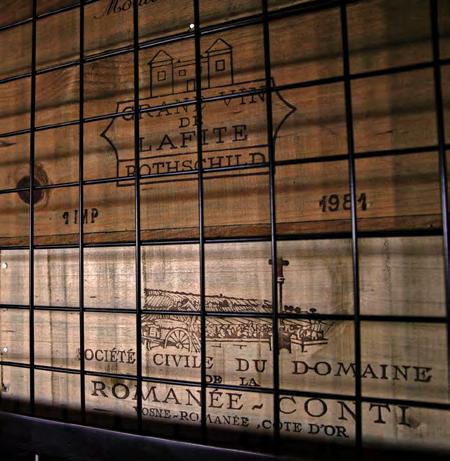
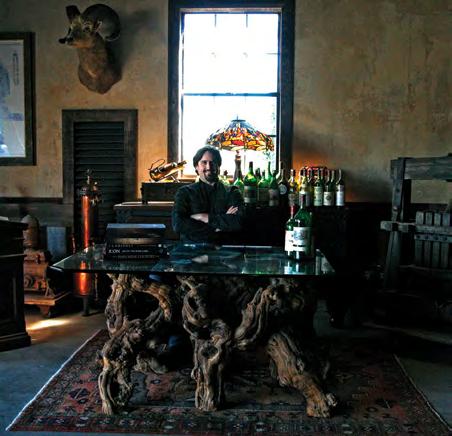


BY LAURIE JO MILLER FARR AND LAURA LARSON
Centuries before love letters, candlelit dinners, or engagement rings, there was wine shared between two people and used as a tool to deepen relationships. Now celebrating 25 years into the story at O’Brien Estate, romance is the foundation of the brand. Barb and Bart O’Brien believe that a shared bottle becomes a ritual—a way to pause, look one another in the eye, and say without words: this matters.
Enter Bill and Claudia Hanna, longtime Napa Valley grape growers whose Chardonnay once made history in the famed Judgment of Paris. The Hannas strolled over to offer a warm welcome and a helping hand. Along with their son Michael, they taught the O’Briens how to nurture vines and grow truly exceptional grapes.
But growing the grapes was just the beginning. Down the road lived another winemak-
“O’Brien wines have elegance and finesse to them, while also being full-bodied with a rich tannic structure of soft tannins and a velvet kiss.” –Robert Parker
For Barb O’Brien, the romance with wine began long before she met her husband, Bart. At just 20 years old, she stunned her professor at Montana State University by delivering a spirited lecture on wines from around the world—complete with paper cup tastings for 35 of her classmates. One skeptical cowboy accused her of trying to “Californicate Montana,” but Barb was undeterred. It didn't take long for her to realize she was, at heart, a true Californian, and she moved to San Francisco. Later, her passion led her to Bordeaux, France, where she lived for six months, immersing herself in French food and wine culture. Following that, she returned to San Francisco, where she met Bart O'Brien, then a software entrepreneur.
It was on their third date in Napa Valley that Barb voiced her dream of owning land and starting a winery. Bart, already enchanted by Barb, quietly tucked that dream into his heart. Twelve years, two children, and one enduring love story later, he made that dream a reality.
The O’Briens purchased a charming winery once owned by the Costello family—the 39th bonded winery started after Prohibition. The transition was anything but seamless. With no experience, no manuals, and a shed full of unfamiliar equipment, Barb and Bart had no idea how to drive a tractor, perform pump-overs, or even farm grapes. But what they lacked in knowhow, they made up for in heart—and a little help from their neighbors.
ing legend—Dave Cofran, one of Silver Oak’s original team members and its longtime general manager. Dave and Bill Hanna partnered to produce the first three vintages of O’Brien Estate. Later, they introduced Barb and Bart to rising star winemaker, David Yorgensen, who had trained under Philippe Melka. David has now been crafting the estate’s wines for over two decades, carefully shaping each vintage under Barb and Bart’s vision.

But the true magic of O’Brien Estate lies not just in the grapes or the terroir—it lives in the love story that inspired the wines themselves. Because while it was Barb’s dream to start a winery, it was Bart’s dream to marry Barb. Together, they created a collection of wines that tell the story of a relationship, from the first spark to lasting devotion. “Because we recognize the importance of wine in creating a bond between two people, romantic poetry is a way to queue up the conversation,” Bart said. “To celebrate our meeting and romance, Barb and I created a series of wines with romantic names.” Each wine in the romantic series—Fascination, Attraction, Flirtation, Romance of the Heart, Seduction, Passion of the Soul, Devotion, and Reflection—marks a chapter in their shared journey. And on the back of every bottle, Bart penned a poem to Barb, capturing the emotions he felt at each stage of their relationship. More than just wine, each bottle is a love letter—a testament to dreams pursued, risks embraced, and a vineyard life built on a foundation of true romance.

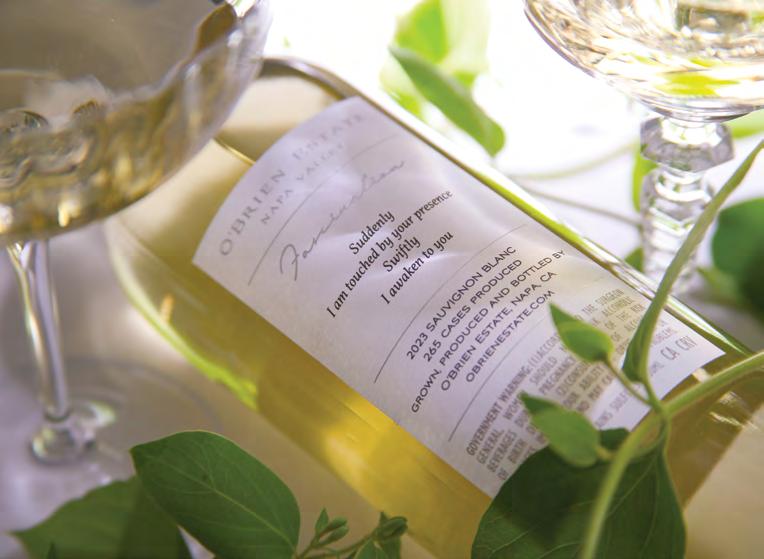
Extend to me
The hand of conversation
Twirl me with laughter
Embrace me with kindness Will you be mine for a moment? Or for a lifetime?
Written by Bart to Barb
When Robert Parker Jr. of Wine Advocate was still personally tasting, he was particularly fond of the O’Brien Merlot. “All three Merlots come from the southern Oak Knoll section of Napa Valley, and all three are brilliant efforts that are as good as Merlot can be.” He added, “O’Brien wines have elegance and finesse to them, while also being full-bodied with a rich tannic structure of soft tannins and a velvet kiss.” A series of mid-90s scores culminated in a 98-point score for the 2013 Unrestrained Reserve.
Upon reaching a quarter-century milestone, it’s widely acknowledged that the number of Napa wineries has nearly doubled since 2000, and corporate interests throughout the valley have expanded significantly. However, not everything has changed. As a family-run business with David Yorgensen as consulting winemaker for over 20 years, the O’Briens are especially proud to remain an independent brand. With only 5,000 cases produced, O’Brien Estate wines cannot be found in stores or restaurants. Bart & Barb like to tease “we don’t sell wine to strangers” because their wines can only be purchased directly from the estate. With ~3000 members in their wine club and a three-month waiting list, O’Brien Estate wines are highly sought after. Bart & Barb live on the estate where tastings are still hosted in their backyard next to the vineyard, often coming out to greet guests, share a glass and exchange stories. The O’Briens make people feel right at home with their relaxed and intimate tastings, welcoming everyone as friends and not just visitors. These types of experiences evoke the nostalgia of wine tasting in the Napa Valley, the way it used to be, with rustic charm and understated luxury. In fact, the experience at O’Brien Estate is so unique that in November 2023, US News & World Report named it the #1 Destination in Napa Valley.
To mark their 25th Anniversary milestone, among other things, O’Brien Estate is putting together Anniversary and Romance packages for couples looking to rekindle their love. It includes ten bottles of wine with a custom label of the couple’s name, to be opened each year on an anniversary for a decade.
Writing their next chapter of the story, Barb and Bart are somewhat wistful but also thankful, looking ahead to the day when the next generation(s) will carry on with the family business.
Their daughter Emily has taken on the role of Director of Operations, handling all day-to-day operations, including marketing,
Through the grant, O’Brien Estate is implementing no-till farming, permanent cover crops, and biodiverse planting to improve the health of the soil and vines. The results of these projects will be shared with every vineyard manager, enabling them to protect Napa Valley and beyond. The project’s motto is “Healthy Vines = Better Wines.”
The O’Briens’ son, Mason, and his wife, Andrea, are not currently involved with the winery, but Bart and Barb have hope that their new grandson, Finn, will take the lead for the next generation to become engaged with the business at the appropriate time.
Meantime, when Barb and Bart are around, look for them on the tasting patio or in the fields. Barb may be hanging around the goats and geese with a glass of

The O’Briens make people feel right at home with their relaxed and intimate tastings, welcoming everyone as friends and not just visitors.
managing the wine club, and customer service-related activities. She also heads the winery’s environmental programs, including its Napa Green Certification and regenerative farming initiatives, thanks to a three-year research grant from the California Land Stewardship Institute.
wine—and it’s easy to spot Bart—he’ll be the one wearing his signature Panama hat. One thing’s for sure: Barb and Bart O’Brien craft wines as unforgettable as their love story—and they invite guests to create a story of their own.




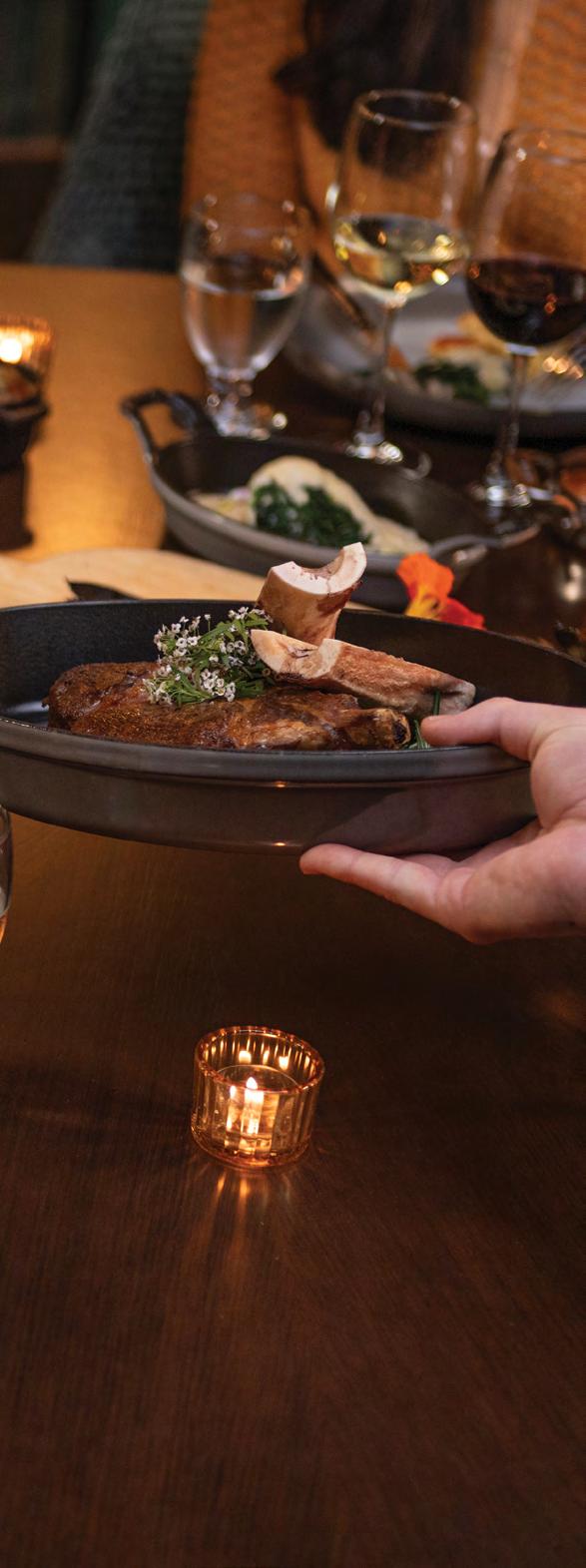
Picture this: rolling vineyards stretching across sundrenched hillsides, historic wineries with stone facades that have weathered decades of harvests, and a dining scene that spans from Michelin-starred establishments to innovative food trucks serving diverse menus. This is Napa Valley—California’s crown jewel of wine country and the spotlight for this year’s celebration of all things delicious.
With more than 400 wineries calling this valley home, Napa’s wine scene runs deeper than most people realize. Visitors will find the household names with their grand estates and trophy rooms, but if they venture off the main thoroughfare of Rt. 29 and the Silverado Trail, they’ll discover family operations where the winemaker’s grandmother still tends the herb garden. From bold Cabernets that age gracefully for decades to luscious Chardonnays perfect for afternoon sipping, the diversity here mirrors the valley’s varied microclimates and passionate personalities behind each bottle.
The food scene has evolved just as dramatically. Michelin stars still shine brightly at legendary establishments, but Napa’s culinary landscape now embraces everything from Vietnamese pho to elevated comfort food. While locals bid farewell to beloved favorites like Napa Noodles, C Casa, NapaSport, and Jax Diner—all of which closed their doors in 2025—exciting newcomers are breathing fresh energy into the valley’s dining scene. A16 brings authentic Italian flavors with their house-made pastas and wood-fired pizzas, while Under-Study transforms seasonal ingredients into unexpected combinations that somehow make perfect sense. RO Restaurant and Lounge elevates the luxury dining experience with fusion Asian cuisine and caviar and champagne pairings, while Carabao delivers Filipino-inspired dishes that reflect the valley’s increasingly diverse cultural tapestry.
What makes Napa special isn’t just the abundance—it’s the interconnectedness. Restaurants source from neighboring farms, winemakers collaborate on innovative food and wine tasting experiences, and visitors find themselves part of a community that genuinely loves sharing what they’ve created. Whether planning an elaborate wine country weekend or simply curious about what’s happening in America’s most famous food and wine destination, these pages will guide readers to some of Napa’s most memorable epicurean experiences.


PHOTOS COURTESY OF FRANK FAMILY VINEYARDS
Summer in Napa Valley brings golden evenings, vineyard blooms, and the return of one of Frank Family’s most beloved wines—the 2024 Leslie Rosé. Now in its fifth vintage, this radiant rosé is more than a seasonal favorite; it’s a tribute to elegance, generosity, and the spirit of its namesake, Frank Family Vineyards CoFounder, Leslie Frank.
Crafted in a Provençal style, the 2024 Leslie Rosé is made exclusively from Pinot Noir sourced from Napa’s cool-climate Carneros region, including Frank Family’s own Lewis Vineyard. The vineyard’s proximity to the San Pablo Bay and Pacific Ocean provides the cooling influence necessary for slow, even ripening. This allows the wine to showcase bright acidity, vivid flavor, and signature minerality. With a delicate blush hue, the wine opens with aromas of apple blossom and rose petals. On the palate, notes of wild strawberry, white peach, and citrus zest come through, carried by a refreshing finish that lingers long after the last sip.
But this vintage offers more than a beautiful sip—it provides an opportunity to sip with purpose. For every bottle of the 2024 Leslie Rosé sold, 15% of proceeds will benefit Dress for Success, a global
nonprofit dedicated to empowering women to achieve economic independence.
For Leslie Frank, this partnership holds deep personal meaning. During her time as an evening news anchor for FOX 13 in Seattle in the early 2000s, Leslie served on the board of Dress for Success’s local chapter. “This organization has long held a special place in my heart,” she said. “I’ve seen firsthand how it transforms lives. Supporting their mission through our rosé is a way to invest in women’s futures and provide the resources they need to thrive.”
Since its founding in 1997, Dress for Success has become the leading global employment resource for unemployed and underemployed women. Through no-cost access to job skills training, career coaching, financial education, mentoring, and professional attire, the organization equips women with the tools and confidence they need to succeed in both their professional and personal lives. With affiliates in nearly 145 cities across 20 countries, Dress for Success has helped over 1.3 million women take the next step toward self-sufficiency.
This initiative is part of Frank Family Vineyards’ ongoing commitment to philanthropy. In 2018, the winery launched
Frank for a Cause, an annual campaign that supports nonprofit organizations both nationally and locally. Past beneficiaries include 4ocean, K9s For Warriors, the Breast Cancer Research Foundation, Feeding America, Autism Speaks, and more. For Rich and Leslie Frank, giving back is at the heart of what they do.
“We’re proud to use our platform to support meaningful causes,” said Leslie. “This year’s rosé is special—not just for what’s in the bottle, but for the impact it will have beyond the glass.” The 2024 Leslie Rosé is available through Frank Family Vineyards’ tasting room and website. Whether shared among friends, enjoyed at al fresco lunches, or given as a thoughtful gift, this wine offers more than just elegance in the glass—it’s a reflection of purpose and heart. Each bottle supports women working toward a brighter future, making every sip a meaningful one. This season, raise a glass to a wine that’s beautifully crafted, deeply personal, and dedicated to making a difference.

www.FrankFamilyVineyards.com









BY FRAN MILLER | PHOTOS COURTESY OF REYNOLDS FAMILY WINERY
Just off the Silverado Trail, where the road curves south of Napa’s Stags Leap District, Reynolds Family Winery sits unobtrusively behind a canopy of oak trees. Behind a modest guest cottage is a story that has taken shape over decades—one of reinvention, resilience, and now, a passing of the torch. There’s no flashy gate or imposing château here—just a family, a vineyard, and a shared commitment to craft.
Steve Reynolds didn’t set out to be a winemaker. For years, he was a practicing dentist. But when he and his wife Suzie bought a rundown chicken farm in the late ‘90s with nine acres of Cabernet vines, something shifted. He left the dental chair behind, dove headfirst into viticulture—taking classes at UC Davis, apprenticing, experimenting—and slowly built a small but devoted following for his expressive, well-balanced wines.
What started as a side project evolved into a deeply personal family business. Today, more than 25 years later, that business is undergoing a quiet but meaningful transformation. Steve’s son Cameron, who grew up watching harvests and hearing cellar talk around the dinner table, is stepping into the winemaking role as a second-generation vintner. His approach brings a new perspective—one that honors the foundation his father laid but looks ahead to where Napa is going, not just where it’s been. “I have so much respect for what my dad built—he poured everything into this place,” said Cameron.
Reynolds Family Winery is best known for crafting well-balanced Cabernet Sauvignon from its estate vineyards—including the renowned Persistence Vineyard. However, the portfolio also features expressive Cabernets sourced from Diamond Mountain and Atlas Peak. It also includes Merlot, Chardonnay, Pinot Noir, Sauvignon Blanc, Rose, and even a sparkling made in the true Méthode Champenoise method.
Reynolds sources fruit from across the valley, yet the estate vineyard—14.5 acres in total—remains its heart. The rows are kissed by cooling breezes from San Pablo Bay, which helps preserve acidity and freshness in the grapes. Steve always said he aimed to make wines that were drinkable now but structured enough to age and that philosophy still guides the winemaking today.
At Reynolds, wine is more than a beverage—it’s a bridge to connection. Here, by-appointment tastings within the Reserve Room are intimate and unhurried. There’s a spring-fed pond, a shaded patio, and a tasting room filled with personal touches. Members are invited to convivial vineyard receptions and thoughtfully curated winemaker dinners, each offering guests moments to engage more deeply with the wines, the land, and the stories they carry. “These aren’t just tastings,” said Cameron. “They’re invitations to be part of something meaningful.”
At the heart of it all is a quiet but essential force: the cellar team. Arturo Irucuta, assistant winemaker, Israel Irucuta,

What started as a side project evolved into a deeply personal family business. Today, more than 25 years later, that business is undergoing a quiet but meaningful transformation.
vineyard manager, Julio Andrade, cellar master, and Zandra Irucuta, cellar hand, bring not only skill, but soul to every stage of the winemaking process, from the first light of harvest to the final blend. “Arturo and his family have been a part of our team and lives for almost 20 years,” said Cameron. “Their craftsmanship and collective decades of experience are woven into every barrel, every bottle. It is their dedication that gives Reynolds Family Winery its spirit—and its strength.”
As Cameron steps forward to take the winery reigns, he plans to continue his family’s focus on making honest wine shaped by the land they’ve come to know so well.
“My goal isn’t to reinvent that legacy, but to build on it in a way that feels relevant today,” added Cameron. “I want to honor our roots while creating wines and experiences that speak to a newer generation
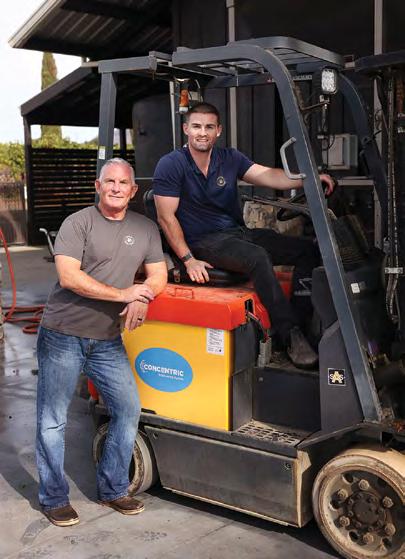
coming to Napa—people who care about authenticity, sustainability, and stories that feel real.”
As Napa Valley continues to evolve, so too does Reynolds Family Winery. Under Cameron’s care, the next chapter promises to keep one foot grounded in tradition and the other confidently stepping into the future. www.reynoldsfamilywinery.com



BY JILLIAN DARA | PHOTOS COURTESY OF BERINGER VINEYARDS
With roots that date back to 1868, Beringer Vineyards is often recognized for its history and position as a pioneer in the valley reputed for its many firsts — from the first winery to offer public tours in 1934 to the first and only winery to have a red and a white wine named #1 Wine of the Year by Wine Spectator Magazine
As impressive as these achievements are, Beringer’s modern chapter is also reputable, including its recent addition of Borrow Pit Vineyard, nestled in the Oakville AVA, and its “powerful yet refined” Cabernet Sauvignon.
“In 2015, an array of six different clones and rootstock combinations were planted here,” explained Sarah Kendrick, assistant hospitality manager of Beringer Vineyards. The site’s topsoil was used in the construction of the Rector Dam in 1946. The remaining ground subsoil was Perkins Gravelly Loam, which provides excellent drainage for Cabernet Sauvignon. “Due to the terroir, the vines struggle to produce clusters of small grapes; the grapes have a high skin-to-juice ratio and concentrated flavors, which give Borrow Pit the sought-after intensity, complexity, and depth,” added Kendrick.
Borrow Pit Vineyard is part of Beringer’s Single Vineyards portfolio that showcases the diverse terroirs of its siteexpressive Cabernet Sauvignon. Borrow Pit contrasts the mountain-driven structure of other vineyards, ranging from St. Helena’s fruit-forward richness to Howell Mountain’s structure and dark fruit, and Spring Mountain’s earthy complexity.
Visitors to Beringer can better understand this range of terroir in a glass with the winery’s Taste of Beringer offering. This 75-minute tasting experience presents a strong educational component from the aromas and flavors of a wine to its culinary complements with rotating pairings to highlight each wine’s distinct characteristics. “Over the years, we have developed an educational, immersive, and unique experience tailored to each individual, whether their wine journey is just beginning or they are seasoned wine aficionados,” said Kendrick. ($95 per person with a club discount available).
Kendrick explained that at the heart of the experience is a sensory garden designed to “awaken your senses” by exploring characteristics one can find in their glass. Meanwhile, the farm-to-table seasonal menu celebrates the season’s
bounty while harmonizing effort with every pour and pairing. “We explore the harmonious relationship between wine and cuisine, highlighting how the right pairings can elevate any experience,” said Kendrick. “Education is a fundamental base of Beringer Vineyards and how we foster relationships with our guests, and truly encompasses a hospitality heart.”
Though the pairings change regularly, Kendrick said one of her favorite seasonal pairings for summer is Borrow Pit Vineyard with a mini-BLT sandwich. “The combination of the rich plum framed by ripe, firm tannins pairs beautifully with the crispy pork belly and fresh buttery brioche.”
While balancing education and an entertaining experience can be challenging, Kendrick explained how confident she is in the team’s hospitality, heart, and passion to customize each reservation to be a perfect mix. “Tailoring to the individual allows us the freedom to educate while keeping the experience light, fresh, and fun.” she said. www.beringer.com



Experience elegant private seated tastings of re ned méthode traditionnelle sparkling wines and pinot noir. Elevate any experience with an exquisite selection of local artisan cheeses, charcuterie, caviar and delectable vegan options, or enjoy an international gustatory journey with our new Bubbles & Bites Mediterranean excursion.
Experience sophisticated méthode traditionnelle sparkling wines and pinot noir at your private seated tasting, sampling local charcuterie, artisan cheeses, caviar and delectable vegan options. Take in an indulgent and dramatic sabrage experience and pop the cork on your mini getaway to Europe in wine country
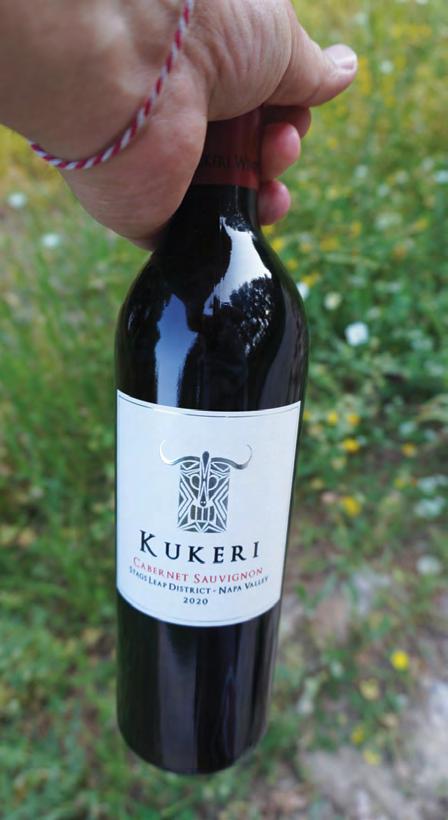
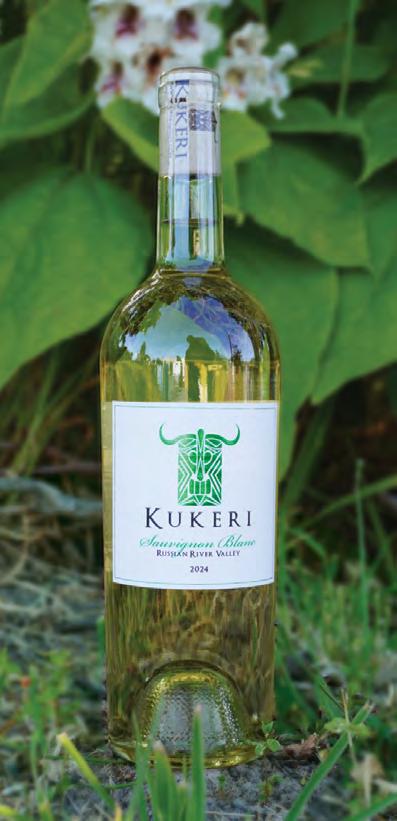
A WRITTEN BY LAURIE JO MILLER FARR | PHOTOS COURTESY OF KUKERI WINES
s founder and winemaker at Kukeri Wines, Petar Kirilov would be the first to say that passion, dedication, and long hours are required to create unique wines. In the production of very small quantities of handcrafted wines, there simply are no shortcuts.
Kukeri Wines: Dedication For Kirilov, reports of declining wine sales are a concern, but the love he pours into his brand at Kukeri Wines is unwavering. “When hard times come along in the wine industry, this kind of commitment is critical to small brands like mine. We must keep working to survive these challenging moments and keep making excellent wines,” he explained.
Kukeri Wines: Tradition
Faced with ever-changing trends, it’s understandable why Kirilov takes the long view. Because inspiration comes from his homeland of Bulgaria, where the ancient roots of winemaking can be traced back over 8,000 years, diligence and optimism are in his DNA. “About 80 percent of the people in my village make their own wine,” Kirilov said. “From an early age, I helped my father with our family wine. After completing my advanced studies in food technology, I carried history and culture from my small town to Northern California. Working with the very best growers in the best vineyards, my goal is to share the high quality that Kukeri represents in a smalllot wine.”
The brand name Kukeri also represents a connection to Kirilov’s homeland. It refers to a traditional Bulgarian ritual of pagan origin involving elaborate costumes and towering masks worn by dancers to ward off evil spirits. Meant to ensure good luck for harvest and a prosperous year, the folklore festival falls in the winter months between New Year’s and Lent. Petar was attracted to the festival when considering names for his wines because he “...wanted something tied to where I come from and who I am.” Today, Kukeri Wines salutes a celebration of life and a legacy of cultural heritage through winemaking.
Kukeri Wines continue to add accolades to an impressive collection of gold medals, double gold medals, best of class, and 100-point awards earned over the past decade.
Kirilov is focused on producing small lots of top-quality wines from some of the best single vineyards in Napa Valley and Sonoma County, such as Stags Leap District, Howell Mountain, Atlas Peak, Mt. Veeder, Oakville, Yountville, Oak Knoll, Chardonnay from the Sonoma Coast, and Pinot Noir from Petaluma Gap and the Russian River Valley. Known for complexity, intensity, balance, and age-worthiness, bottles of Kukeri Wines continue to add accolades to an impressive collection of gold medals, double gold medals, best of class, and 100-point awards earned over the past decade. These include prestigious international events such as the San Francisco Chronicle Wine Competition and Sunset International Wine Competition, where the 2023 Kukeri Napa Valley Cabernet Sauvignon won double gold, and the 2024 Kukeri Russian River Valley Sauvignon Blanc won best of class and double gold. While there is no tasting room for visitors, Kukeri Wines are available directly to consumers online and in select wine shops, including Sonoma Wine Shop, Ferry Plaza Wine Merchant, and Mission Bay Wine and Cheese Shop.
www.kukeriwines.com



BY FRAN MILLER | PHOTOS BY ALEXANDER RUBIN COURTESY OF SEQUOIA GROVE
Set beneath towering redwoods in Napa Valley’s Rutherford AVA, Sequoia Grove Winery takes a refreshingly relaxed approach to fine wine and food. This family-owned estate is known for its bold Cabernet Sauvignons and warm hospitality, but it’s the winery’s elevated culinary offerings that truly set it apart. Here, the pairing philosophy defies convention, thanks to Executive Chef Spencer Conaty, whose Michelin-starred background meets a playful sense of creativity.
At Sequoia Grove, food and wine are inseparable, clearly illustrated in the “Wines + Bites” tasting, a snackable introduction to pairing. Served outdoors beneath the sequoias, four expressive red wines are matched with seasonal small bites that both complement and challenge the palate. A guest favorite? The Caramelized Shallot Dip with Chive Oil and Potato Chips, made with Bellwether Farms ricotta. Rich and creamy, it draws out the vibrancy in the accompanying reds.
Another standout is the Honey Mustard Pretzel Crunch, a textural mix inspired by Napa’s mustard season. Estate-grown mustard flowers are dried and infused into estate-sourced honey, then used to glaze
the crunchy blend. It’s the kind of dish that would traditionally overwhelm a red, but here, it lifts the tannins and enhances the wine’s structure. “I like doing something unexpected,” said Conaty. “Taking you outside your comfort zone with pairings you’ve been told won’t work, then using uncommon ingredients and techniques to create something that not only works, but elevates the wine.”
For a deeper dive, the “Taste of Sequoia Grove” offers a flight of four estate wines— including the coveted Rutherford Bench Reserve Cabernet—served in the estate’s historic barn or lush garden. This tasting connects wine with place, offering insight into the valley’s diverse AVAs and the winemaking philosophy behind each bottle.
Those looking for a more immersive experience can book “A Taste for Cabernet,” the winery’s showstopping multi-course pairing. This is where Conaty’s culinary creativity shines brightest. One recent dish, Cavatelli Succotash, reimagines a Southern staple with smoked Brentwood corn, black pepper pancetta, and house-made pasta. Corn is notoriously difficult to pair with Cabernet, but cold-smoking it and layering in smoky paprika and pancetta creates the umami
depth that matches the wine’s tannins and toasted barrel notes. Each plate in the experience is designed to reveal a different facet of Sequoia Grove’s reserve-level reds, including its flagship Cambium, offered as part of a rare vertical tasting.
Despite the pedigree of the wines—and the precision of the pairings—Sequoia Grove is a casual, come-as-you-are spot. Tastings are tailored to one’s curiosity, whether they’re a seasoned collector or just getting to know Napa reds. Reservations are recommended, especially for food pairings, but the tone remains unfussy and inviting, and walk-ins are often welcomed for casual tastings. At Sequoia Grove, great wine is the starting point. But it’s the unexpected—and unforgettable—pairings that linger longest. Expect to leave with a deeper appreciation for the craft behind the glass—and a few new ideas about what goes with Cabernet.


BY FRAN MILLER | PHOTO BY LUNA VERA COURTESY OF ROMEO VINEYARDS
At Romeo Vineyards & Cellars in downtown Calistoga, summer isn’t just a season—it’s a weekly celebration. From Memorial Day through October 31, the charming tasting garden transforms every weekend into a laid-back gathering of music lovers, wine enthusiasts, and pizza fans with the launch of their Pizza Saturdays and Friday/Sunday Happy Hour Music Series.
Set against the backdrop of towering redwoods and blooming flowerbeds, Romeo’s outdoor courtyard feels more like a secret garden than a winery. Tables are scattered beneath the shade, fountains gurgle softly, and the historic 19th-century Carriage House adds a touch of old-world charm.
Saturdays are for Pizza & Wine, when from 1 to 4pm, brick-fired pizzas are served hot from the oven—classic Margherita, crowd-pleasing Pepperoni, and a rotating weekly special, each priced at $18.
On Fridays and Sundays, Happy Hour prices apply to wines, and local musicians take the stage from 4 to 6pm, filling the garden with a range of genres, from jazz to acoustic rock. Many of the performers
are low-key legends—former Broadway or touring pros who’ve made their homes in Napa Valley and now bring an easy elegance to the weekend scene.
But even with the music and food, the wine still takes center stage. Romeo Vineyards produces fewer than 4,000 cases of wine a year, all of which are red wines grown on their 40-acre estate, located just a few miles away. The vineyard was restored and replanted by founder Frank Romeo and his late wife, Eugenia, in the late 1990s, using Bordeaux clones that now yield structured, age-worthy wines. Their first vintage, released under the name Sempre Vive (“always alive”), set the tone for what Romeo Cellars would become: rooted in tradition, yet always evolving.
Legendary winemaker Alison Green Doran—California’s fourth-ever female winemaker and a protégé of André Tchelistcheff—has led the winemaking since 2003. Her confident, expressive style gives each vintage a sense of clarity and depth, from bold Cabernet Sauvignon to elegant Merlot and Petite Verdot. The whites—Sauvignon Blanc, Chardonnay,
and Muscat—are sourced from nearby North Coast vineyards and offer a refreshing contrast to the reds, especially on warm summer afternoons.
Inside the tasting room, hand-painted murals by local artist Carlo Marchiori depict whimsical Puccinello characters bumbling through the winemaking process. It’s a playful nod to the winery’s spirit: serious wines, delivered with a wink.
“We treat people well here, and we feel really good about the wines,” said Frank. “But more than anything, it’s a place where people can enjoy themselves.”
And enjoy they do. With great wine, fresh pizza, and live music under the redwoods, Romeo Vineyards has mastered the art of the summer hangout. Stop by on a weekend, and visitors might linger until the last note fades


Napa County neighbors enjoy special o ers from select local Napa Valley wineries — just for living here! No membership needed, simply show your driver’s license and enjoy.
BY FRAN MILLER | PHOTO COURTESY OF EMBER
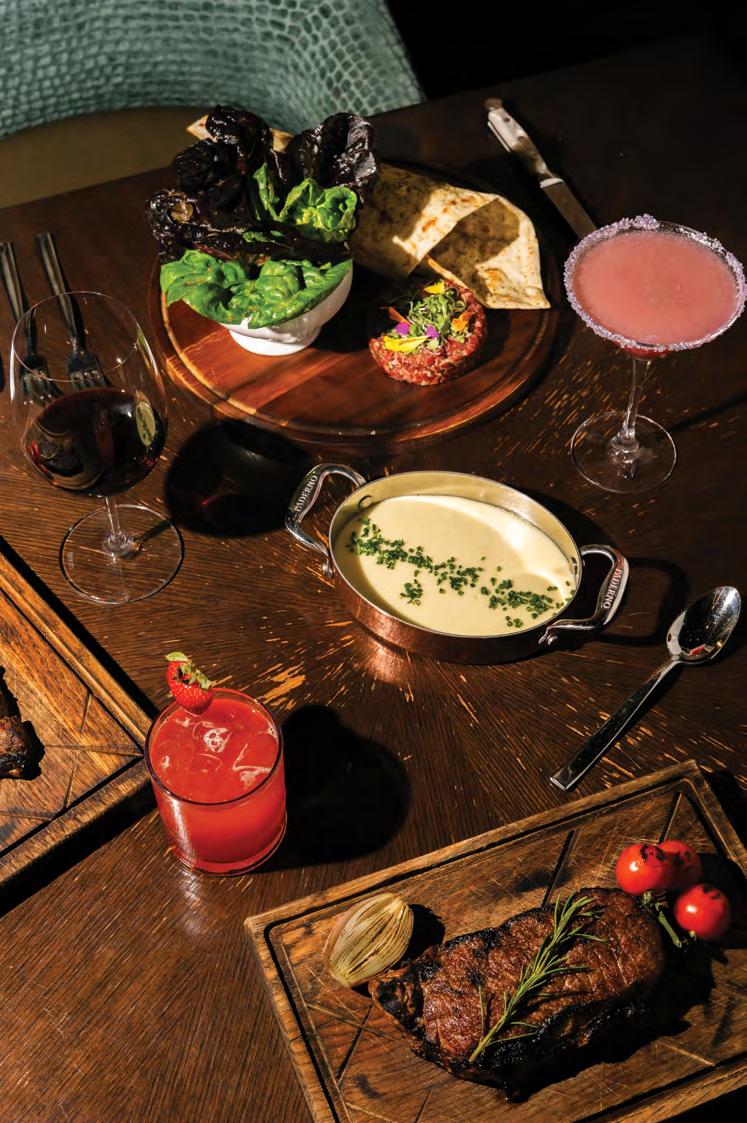
Ayear ago, Ember lit its first flame.
Now, the signature steakhouse at The Meritage Resort and Spa is entering its second year with new energy, a new chef, and the kind of atmosphere that invites indulgence.
Dark marble, warm wood, and flickering candlelight define Ember’s intimate 50-seat dining room. A teal-accented bar glows softly in the corner, beneath the watchful eyes of a steer painted on canvas. There’s Sinatra in the background. A cocktail in hand— maybe the Barrel Aged Black Manhattan with Smooth Ambler Contradiction Rye
Whiskey, Amaro Montenegro, Angostura, and orange bitters. This is not a typical hotel restaurant. Ember feels like a secret: moody, elegant, and deeply personal.
Now leading the kitchen is Nicole Heaney, a Wyoming-born chef whose approach blends ranch-raised toughness with refined culinary technique. “I want to bring the best of everywhere I’ve worked,” she said. “And help my team grow—not just as cooks, but as future chefs.”
Heaney grew up in Douglas, Wyoming, in a family that hunted elk, fished trout, and drove across state lines to bring home whole
bison. She speaks about Highland cattle and heirloom vegetables with reverence and fluency. That farm-to-fire ethos now guides Ember’s menu, where dry-aged ribeyes meet precise technique, and even the simplest ingredients—say, a potato pavé—get torched tableside in dramatic fashion.
Guests begin with raw bar selections that rival any coastal fine-dining room: seasonal oysters, a sashimi trio, and varied rolls. From there, the menu unfolds with chargrilled steaks, seasonal vegetables, and rich, detail-obsessed sides. The presentation of the steak knives, in a velvet-lined box delivered tableside, is a fun highlight. Choose your blade, then carve into something unforgettable. And be sure to leave room for decadent desserts.
“I want to bring the best of everywhere I’ve worked, and help my team grow—not just as cooks, but as future chefs.” –Chef Nicole Heaney
Ember recently earned a Wine Spectator Award of Excellence, and it’s easy to see why: the cellar leans heavily on Napa’s boldest reds, with deep nods to Old World producers and Trinitas Cellars anchoring the list. For those who prefer bubbles, many begin the evening just steps away at Sora, The Meritage’s new sparkling wine bar— though make no mistake: it’s Ember that steals the show.
Complimentary valet parking makes it easy to settle in and stay awhile. And under Heaney’s leadership, Ember feels sharper, more confident, and more magnetic than ever. “I’m focused on local sourcing, skilled technique, and thoughtful flavor,” she explained. “And I’m obsessed with details.”
Ember might be a steakhouse, but it is more than that. It’s a place where fire and finesse share the spotlight—and every dinner feels like an occasion, which can be made even more memorable with an overnight stay.

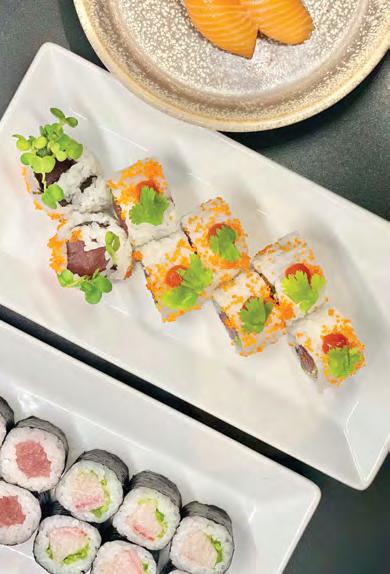


BY LAYNE RANDOLPH | PHOTOS COURTESY OF EIKO’S
The scent of sizzling teriyaki fills the air as regulars settle into their favorite seats at Eiko’s—a Napa Valley mainstay where sashimi arrives daily from the Pacific Rim. In the heart of wine country, Eiko’s has spent over a decade proving that seafood doesn’t need an ocean view to be world-class.
“People think we’re not close enough to the ocean to get fresh fish,” said Allison Hallum, Director of Operations at Eiko’s Inc. “But our fish is flown into our nearby international airports from all over the world. We use the best salmon called Ora King Salmon from New Zealand, line-caught big-eye tuna from Hawaii, and Uni from Japan.”
That meticulous attention to product is part of a deeply rooted family philosophy inspired by the restaurant’s namesake. “Eiko was a person,” Hallum said. “She passed in 2014, and our philosophy from the restaurant view was to always run it tight and fierce like Eiko would have. We keep our staff focused on the locals and our regular families and customers. Eiko also cared a great deal about quality products, food being visually beautiful, and our chefs’ attention to detail.”
That drive for excellence doesn’t stop at the fish counter. Thirteen years ago, Hallum stepped in to run day-to-day operations alongside her father and Eiko’s co-founder, Rick Zaslove, and introduced a change that
“We like to think we adapt and change with the seasons, but we try to be consistent, so you can always expect a great experience with great high-quality food.”
–Allison Hallum
would improve the restaurant’s culture. “I knew we needed to implement employee benefits for our full-time employees to stay and to create an environment that restaurant employees did not want to leave,” she said.
“We did not like the cyclical behavior common in this industry but disagreed on the additional costs. We are so grateful for our long-term employees. I can proudly say we have offered benefits to all of our full-time staff for over 12 years now. It’s saved us a lot on training and has created a strong retention.”
The menu reflects that same loyalty and fun, with a few inside jokes rolled into the sushi lineup. “The Ricky Ricardo and Ricky on Vacation are both named after my dad, while we joke that the Hot Mama Roll is named after my mom, Nancy,” Hallum shared.
But the real secret? It’s in the sauce. “I think the most special things on our menu are Eiko’s original teriyaki sauce recipe or her iconic sesame sauce, for which we constantly get asked the recipe or are asked to bottle. It’s delicious and addictive.”
Even the restaurant’s design hides small tributes to the ocean and the people who shaped it. “Our host stand was originally designed to look like the bow of a boat... I do not think people realize that nod to the ocean,” Hallum noted.
That quiet attention to detail, from sushi to service, keeps Eiko’s at the center of Napa’s dining scene. “I think at this point we are a staple of quality seafood in Napa,” Hallum said. “We like to think we adapt and change with the seasons, but we try to be consistent, so you can always expect a great experience with great high-quality food, but always with a local and fun twist.” Eiko’s will be adding even more great menu items soon. Look for their expanded Noodle menu featuring slow-roasted meats and savory Ramens this summer.




BY FRAN MILLER | PHOTOS COURTESY OF SILVERADO RESORT
Silverado Resort Executive Chef
Patrick Prager wears many hats— and wears them well. Overseeing The Grill, Mansion Bar and Terrace, Market and Bakery, and Banquets, Prager brings a deeply intentional approach to the resort’s diverse culinary offerings. From elegant wine dinners to garden-fresh cooking classes, every plate reflects a lifetime of experience, a passion for teaching, and a reverence for seasonal ingredients.
Born and raised in Alameda, California, Prager’s first taste of hospitality came at Loard’s Ice Cream, where he learned that serving a scoop could mean more than just handing over dessert—it could mean delivering a moment of happiness. That commitment to service has followed him through kitchens in Boston, Chicago, San Diego, Atlanta, and San Francisco, where he trained under some of the country’s best, including Michael Mina at Aqua and XIV.
In 2022, Prager joined Silverado Resort, drawn by the opportunity to create in one of the world’s most celebrated culinary regions. His cuisine—rooted in California sensibilities with classical French technique—feels right at home in Napa Valley.
“Though my feet are planted in local soil, my hands often work with classical French techniques—because discipline and tradition are the foundation upon which innovation stands,” said Prager, a frequent guest on LIVE! in the Bay. “From a perfectly emulsified sauce to a properly trussed chicken, these techniques are not constraints but tools for expression.”
Technique alone doesn’t define his cooking. “I believe that food tastes better when it’s made with joy,” he said. “A happy cook isn’t just stirring a pot—they’re stirring a memory, a mood, a moment. Call it energy, call it love—but it’s real, and it matters.”
That energy is palpable in Prager’s Garden-to-Table Cooking Class, a signature summer series held in Silverado’s open-air garden. Guests harvest ingredients, cook a seasonal dish together, and dine al fresco alongside curated wines from local producers like AXR, Etude, and Trefethen. The result is less a class and more a celebration of connection, place, and flavor.
“At the core of every plate I serve is a deep respect for seasonality and locality,” Prager explained. “Ingredients are like stories: the closer they are to home and
their natural rhythms, the more honest and compelling they are. I believe deeply in reinterpretation. The classics inspire me, but I see them as invitations, not commandments. The past guides the present— but doesn’t dictate it.”
His influence also extends beyond the plate. A certified sommelier, avid cyclist, emerging painter, and devoted family man, Prager is active in philanthropy, supporting causes like No Kid Hungry via their annual Chefs Cycle. He was recently named People’s Choice Winner at Hall’s 2025 Cabernet Cookoff, earning $10,000 for charity.
“So this is how I cook: joyfully, intentionally, seasonally. I honor where I am, where I’ve come from, and the shoulders I stand on. But I never stop moving forward. Because food, like life, is better when it’s evolving—with purpose, with passion, and with play.”

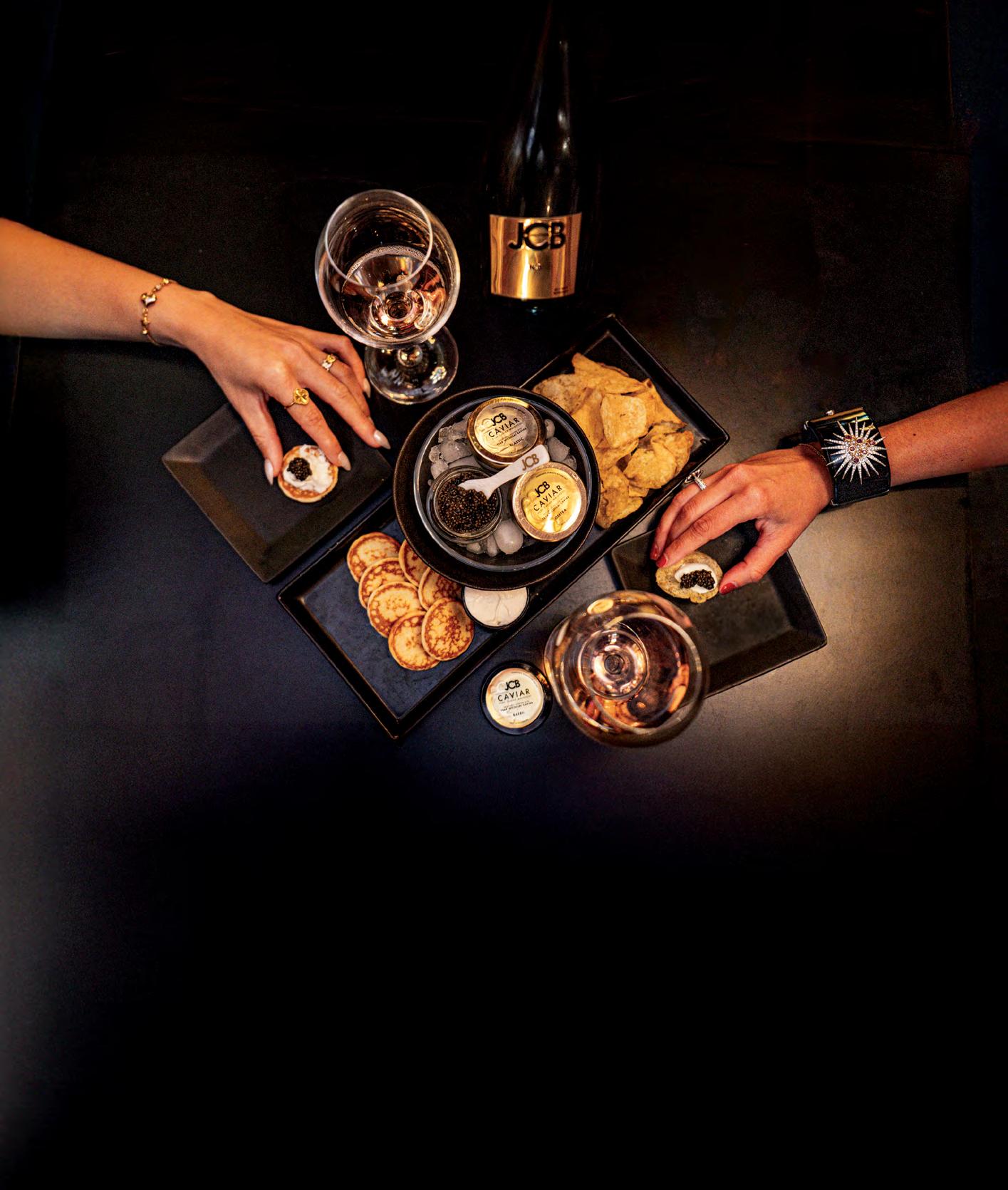


BY LAYNE RANDOLPH
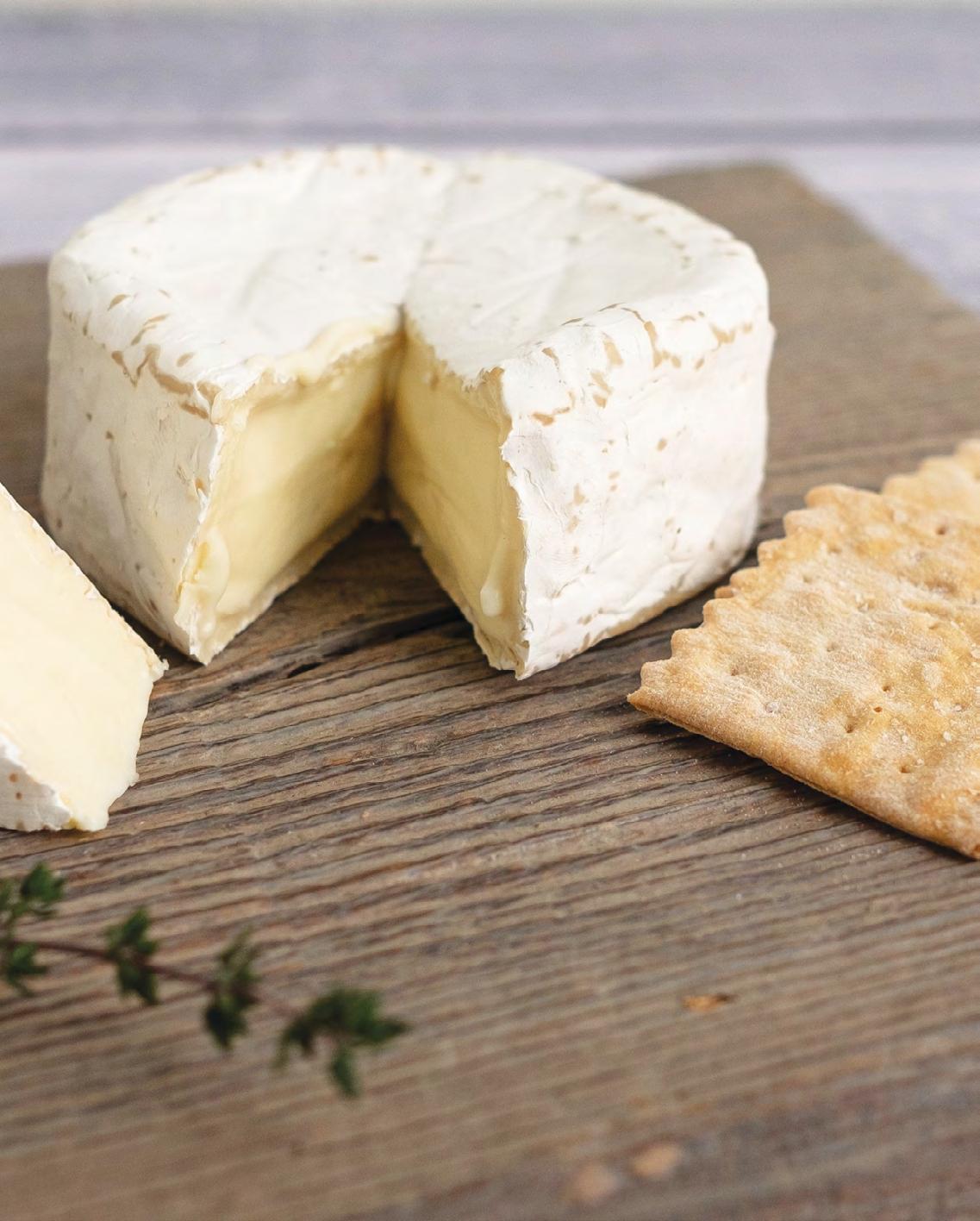

It started with a map to put California’s artisan cheesemakers on the radar. It was a labor of love, a grassroots attempt to connect curious travelers with familyowned dairy farms. Michael Straus, who co-founded the Cheese Trail project with his sister Vivien Straus, has seen its transformation firsthand.
“The map started as the Sonoma Marin Cheese Trail, but because of significant demand, it quickly expanded to statewide within a few years,” Michael shared. “We printed 40,000 maps in 2022. This year we doubled it,” he said. “We’re expanding into other states and adding more to the map: cheese shops, hotels, wineries, restaurants. We’re creating a broader experience.”
The impact of the project was immediate. “Within the first couple of months after the first map was printed in 2011, Marin French Cheese reported that their on-site sales increased something like 25 percent,” Michael recalled. “So, the project had a huge positive effect on the artisan cheese community statewide.”
Initially established as a nonprofit, the Cheese Trail has transformed into a mission-driven LLC dedicated to promoting artisan cheesemakers, supporting small farms, and fostering a cheese-loving community. Over the years, it has connected consumers with the artisans behind some of the world’s most celebrated cheeses. It has also helped to bolster the reach and viability of small-scale producers and family farms. As interest in regional food experiences grows, the Trail has become a cornerstone of California’s agritourism economy.
Today, the Cheese Trail features 44 cheesemakers spanning the state. Visitors can meet the nuns of a mountaintop cloister who craft Old World wheels or stop by a bakery-turned-creamery serving softripened goat cheese with morning espresso. The journey is as much about stories as it is about samples.
According to Michael, cheesemakers have seen measurable benefits. “We’ve heard reports that the Trail drives up to 80% of retail traffic for some participants,” he notes. “That kind of exposure helps small producers survive in a tough market.”
The Trail is also deeply personal. Michael and Vivien live on their family ranch outside Marshall, where they grew up helping run what became Straus Family Creamery. While they’re no longer affiliated with the creamery, they still raise dairy cows and host
weddings and vacationers on the Strauss Home Ranch—now featured on the Cheese Trail for its hospitality and heritage.
A drive along the Cheese Trail in Sonoma County offers a perfect pairing of landscapes and flavors. In a region synonymous with world-class wine, the California Cheese Trail feels not only complementary but essential. Just as wine reflects the terroir of its vineyard, artisan cheese tells a story of local pastures, breeds, and traditions.
Like the historic wineries of Sonoma and Napa, these creameries are rooted in an agricultural ethos predating California’s reputation for fine wine or farm-to-table fare.
Many of the creameries on the trail are nestled among vineyards, and wine-andcheese pairings have become staples at tasting rooms throughout the state. Both




industries champion small producers, seasonal nuance, and a deep respect for the land. For travelers, the Cheese Trail enhances any wine country itinerary, offering rustic charm, flavorful surprises, and a tangible connection to California’s agricultural roots.
Ask any cheesemaker what inspired them to get into the business, and they’ll tell you about grandparents who milked cows before dawn, land that’s been in the family for five generations, and recipes scribbled in the margins of old notebooks. Like the historic wineries of Sonoma and Napa, these creameries are rooted in an agricultural ethos predating California’s reputation for fine wine or farm-to-table fare.

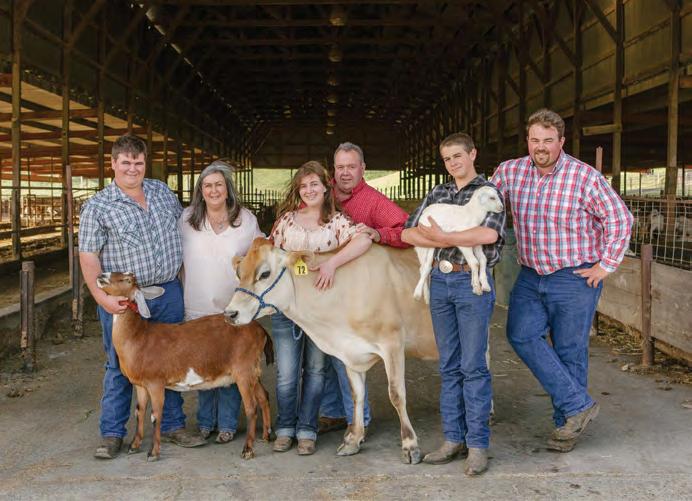
The Northern California (Sonoma and Marin Counties) part of the trail offers a plethora of tasting and visiting options. Petaluma’s Victorian charm masks a fierce commitment to farmstead heritage. Just east of downtown, on a stretch of open pasture, Achadinha Cheese Company offers a window into a working dairy that feels untouched by time. The Achadinha family— Portuguese for “little fountain”—has been tending this land for generations. Their goats and cows are not just milk producers, they’re personalities, each contributing to the signature blends in their fresh chevre, aged Capricious, and playful curds. The tour is earthy and hands-on: guests may pet goats, step into the creamery, and sample cheeses straight from the aging room.
A 20-minute drive through rolling farmland leads to a historic gem: Marin French Cheese Co . Technically across the county line in Marin, it is practically an honorary Sonoma business, a staple in its cheese lovers’ charcuterie board choices. Established in 1865, it is America’s oldest continuously operating cheese company, but you wouldn’t know it from its youthful energy. Here, triplecream brie and camemberts are king. The tasting room offers curated flights, and guests can picnic beside a lily-covered pond. It’s a reminder that cheese can be elegant and relaxed, ideally suited to sunshine and a rustic baguette.
From there, head north to Sebastopol to visit Wm. Cofield Cheesemakers. Cofield
focuses on British-style wheels: crumbly cheddar, pungent Stilton-style blues, all made with local milk. As of 2025, the creamery also houses Alemar Cheese Company, known for award-winning softripened styles. It’s a one-two punch of European flavor with Sonoma terroir.
Further west, Valley Ford Cheese & Creamery blends five generations of dairy tradition with bold innovation. It is a shining example of old-school dairy values meeting new-school flair. Using milk from Jersey cows raised on their own pastures, the creamery’s stars include “Estero Gold,” a Monterey Jack-style cheese with deep umami notes, and “Highway 1,” a creamy fontina-like wheel. Their café serves breakfast sandwiches and espresso, making this a one-stop morning indulgence.
The town of Sonoma offers more stops. Vella Cheese is an icon, famous for its Dry Jack. Epicurean Connection runs cheesemaking classes in town. And Spring Hill Jersey Cheese offers retail and a nostalgic vibe.
The Cheese Trail captures Sonoma’s legacy of agriculture and craftsmanship and connects visitors to the land and the makers. It reminds us that tradition is worth preserving, gives us a true sense of place (with taste!), and delivers nostalgia and real-world delicacies.
And that’s just Sonoma. Nearby Marin County adds even more flavor:
• Point Reyes Farmstead was the first to make blue cheese commercially in California.
• Nicasio Valley Cheese is the state’s only certified organic, farmstead cheesemaker.
• Ramini Mozzarella makes rare buffalo cheese, which is available at farmers’ markets.
Today, the Cheese Trail is expanding in scope and ambition. The team is exploring ways to include cheese retailers, wine bars, restaurants, and hospitality destinations across California—and beyond. The goal? To create a deeper and more connected visitor experience.
“The Trail has already had a huge effect on the artisan cheese community statewide,” Michael said. “But the potential for connection, culinary storytelling, supporting farmers—it’s bigger than just one state.”
“Even though it’s been incredibly successful already, we realize there’s still a lot of growth potential,” Michael said. “We’re just beginning to hit our stride.”
The Trail’s website now includes a robust cheese directory, searchable by milk type, style, or region; curated driving itineraries; and a business-to-business portal linking
artisans with retailers and restaurants. It has become the go-to resource for discovering many of California’s 600+ handmade cheeses from small family farms. What started as a printed guide is now the state’s most comprehensive cheese tourism resource.
FOR MORE INFORMATION www.cheesetrail.org
Many of these businesses are small and family-run, some are historic, and others are just getting started. All are committed to sustainable practices, animal welfare, and handcrafted flavor.
Epicurean Connection
Sheana Davis, a central figure in California’s cheese scene, leads cheesemaking classes and events.
Vella Cheese Company
Iconic producer of Dry Jack cheese. Historic, family-run operation still making cheese in stone buildings from the 1930s.
Spring Hill Jersey Cheese
Creamy, classic cheeses from Jersey cows. Their shop in downtown Petaluma is a cheese lover’s haven.
Marin French Cheese Co. America’s oldest continuously operating cheese company (since 1865). Specializes in triple-cream brie and camembert—picnic-perfect location.
Achadinha Cheese Company
Farm tours, cheesemaking classes, and award-winning goat and cow milk cheeses. Family-run with a hands-on experience.
Wm. Cofield Cheesemakers
It is known for English-style cheddar and Stilton. As of
2025, it shares a space with Alemar Cheese, which offers award-winning soft-ripened cheeses.
Valley Ford Cheese & Creamery
Five generations of dairy farming, farmstead cheeses like Estero Gold, and Highway 1. Includes a café, catering, and ice cream.
Ramini Mozzarella
Makers of rare water buffalo mozzarella. It is not open for tours currently, but can be found at local farmers’ markets.
Point Reyes Farmstead Cheese Co.
California’s first blue cheese producer. Offers tastings, classes, and sweeping views of Tomales Bay.
Nicasio Valley Cheese Company
Third-generation SwissAmerican family. Only certified organic farmstead cheesemakers in California. Alpine-style cheeses.

BY LAURA LARSON
While tourists flock to Michelin-star establishments and celebrity chef restaurants, Napa Valley locals gravitate to neighborhood gems, where vineyard workers grab lunch, winemakers unwind after work, and families celebrate without breaking the bank. This insider’s guide reveals just a few of the favorite dining spots where Napa locals gather to enjoy Napa’s best food and relaxed, community-friendly dining experiences.
Located in the heart of downtown Napa, Eiko’s is a beloved local hotspot known as much for its food as for its lively “scene.” With upbeat music, a sleek bar, and friendly service, it’s the kind of place where sushi cravings and social nights come together effortlessly. The menu also features Japanese comfort food favorites, like crispy tempura and savory ramen, making it a go-to for a wide range of tastes. Eiko’s has been a local cornerstone since it opened its doors in 2011, when Rick Zaslove and sushi master Eiko Nakamura founded it. The family-owned vibe continues under Rick, alongside his daughter, Allison Hallum, who serves as the Director of Operations. Locals love more than just the food—With happy hour served weekdays from 4–6pm, the bar offers specially priced beers, cocktails, sake, and Japanese tapas. Add in rotating seasonal specials and a sake list that invites exploration, and it’s easy to see why Eiko’s is always buzzing.
1330 First St., #385, Napa // www.eikosnapa.com
Downtown Napa’s The Q brings “American Heritage fare including authentic Memphis Style Barbeque” with a modern twist that locals appreciate. This casual spot has carved out a unique niche by offering soul food staples such as fried chicken and collard greens with ham hocks that are nearly impossible to find elsewhere in wine country. Especially popular are Mondays from 11am to 8pm, when a 10-piece bucket of fried chicken goes for just $28. It’s traditionally prepared Southern-style with barbecue sauce or their signature pepper vinegar—Eat in or carry out. The creative twists on traditional sides—such as Asianinfluenced coleslaw and cornbread with honey butter—demonstrate how the restaurant strikes a balance between authenticity and innovation. Along with its soulful R&B soundtrack and welcoming atmosphere, The Q feels like a neighborhood gathering place.
1313 Main St, Napa // www.theqrandb.com
Cheve
La Cheve Bakery & Brews is a cherished local bistro in Napa, situated within the historic Cayetano Juárez Adobe (Napa’s oldest building, dating back to the 1840s), offering a welcoming atmosphere that seamlessly blends heritage, brunch, bakery,
and brewery into one beloved destination. Locals rave about the rich Mexican American brunch: everything is made from scratch, blending comfort food with creative flair. What cements La Cheve’s spot in local hearts is its family-run spirit. Owner Cinthya Cisneros, the daughter of the chef and baker, built it from her garagebrewing roots into a community hub that supports Latino youth, provides scholarships, and features live mariachi and Folklórico performances on weekends. La Cheve blends history, culture, handmade food and drink, and community in a way that keeps locals—and visitors—coming back.
376 Soscol Ave, Napa // www.ilovelecheve.com

Long before downtown Napa became the bustling destination it is today, Angéle took a risk by opening in a converted boathouse along the Napa River. More than a decade later, this French country-inspired restaurant remains a local favorite precisely because it hasn’t chased trends or inflated prices to match its increasingly upscale neighborhood. The restaurant embodies the kind of European-style dining that locals crave—unhurried meals focused on seasonal ingredients and classic technique. Winter evenings call for Boeuf Bourguignon paired with a Negroni, while summer brings al fresco riverside dining with Provence-style rosé and fresh oysters. The cozy bar is one of Napa’s most popular hangouts for happy hour, where the bartenders know many of their customers on a first-name basis.
540 Main St., Napa // www.angelerestaurant.com


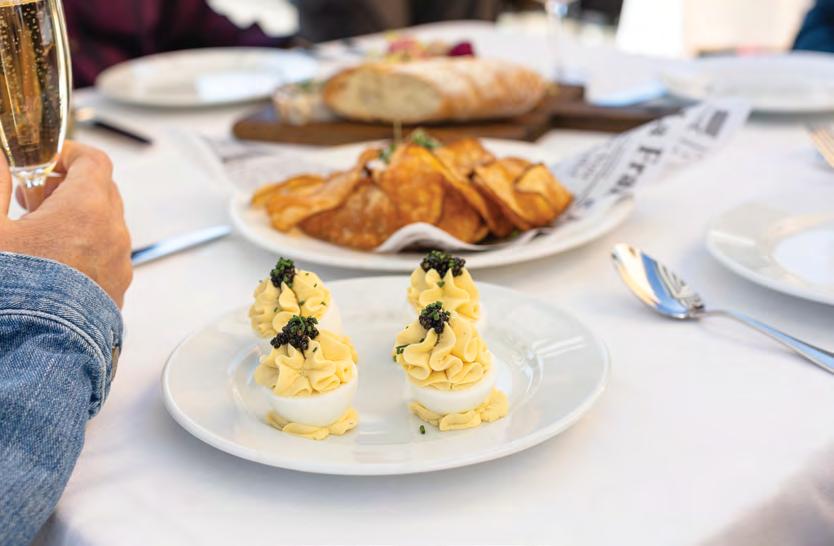

Norman Rose Tavern
Norman Rose Tavern is cherished in Napa for its warm, casual bistro vibe, serving up American favorites with a local twist. Centrally located downtown on First Street, it’s a top stop for locals. The atmosphere is relaxed and people-friendly—patio seating, friendly servers, flat screens showing local sports, and a laid-back crowd make it feel like a home away from home. Dishes highlight Napa Valley ingredients. Standouts include the buttermilk-fried chicken sandwich, cheeseburgers, lamb burger, fish & chips, and indulgent truffle-parmesan fries—locally inspired comfort classics. The bar at Norman Rose is always abuzz with locals enjoying their drink menu, which features 15 rotating craft beers on tap and over 40 wines by the glass (with
no corkage fee on the first bottle), making it a go-to gathering spot for a casual drink or happy hour.
1401 First Street, Napa www.normanrosetavern.com
Bistro Don Giovanni
Bistro Don Giovanni—fondly known as “Don G’s” by Napa locals—is a beloved Italian bistro that’s been captivating the community since 1993. Hidden among olive groves and vineyards just off Highway 29, the restaurant offers a charming setting: warm, wood-beamed interiors with leather booths and an inviting bar, a cozy porch, and an outdoor patio with vineyard views, complete with a central water feature. The menu shines with handcrafted pastas, wood-fired pizzas, and comforting classics, such as Mamma Concetta’s meatballs, short-rib ravioli, and Pollo alla Diavola. Desserts—such as creamy tiramisu, “Bostini” trifle, and their signature butterscotch pudding—are of local legend. What keeps locals returning is not just the food but the ambiance and local camaraderie. The friendly, old-school service, often hosted by owner Giovanni Scala (“Gio”), and lively bar, where locals and vintners hang out, make it feel like Napa’s communal stomping ground. Whether it’s an intimate date, a family milestone, or a casual evening with friends, Bistro Don Giovanni delivers consistent quality, warmth, and unmistakable Napa charm.
4110 Howard Lane, Napa www.bistrodongiovanni.com
Heritage Kitchen & Taps
Heritage Kitchen & Taps—often referred to as Heritage Eats among locals—is a favorite Napa destination, thanks to its vibrant fusion of global flavors, casual atmosphere, and community-focused spirit. Since opening in 2015 by Ben and Ali Koenig, inspired by a year-long journey “traveling around Southeast Asia, India, Israel, Egypt, and beyond in search of daily life food staples,” Heritage offers dishes like smashstyle burgers topped with crispy cheese skirts, bao buns filled with jerk chicken or pork belly, dirty fries, tacos, rice bowls, and vegan/vegetarian options—all using ingredients sourced within a 50mile radius. Generous portions and approachable pricing—many items under $10—make it a reliable spot for budget-friendly meals in a town known for its upscale dining. Heritage Kitchen & Taps has been newly designed to offer a more in-house dining experience, where diners can sit, enjoy great food, and connect with the local community.
3824 Bel Aire Plaza, Napa www.heritageeats.com
Located in the Browns Valley neighborhood, Hop Creek Pub has become a go-to spot for Napa Valley locals seeking comfort food, craft beverages, and a relaxed, neighborhood feel. Known for its welcoming vibe, this neighborhood gastropub offers a rotating menu of local drinks and elevated pub fare. Favorites include grilled fish tacos, juicy burgers, crispy calamari, and artisan flatbreads—all served with warm, attentive service. The dog-friendly outdoor patio adds to the charm, offering a leafy, relaxed setting that feels more like a backyard gathering than a restaurant. Locals often praise the space as perfect for everything from casual family dinners to low-key date nights. Owned and operated by longtime Napa residents, Hop Creek Pub reflects the easygoing, unpretentious spirit of the area. It’s a place where familiar faces gather, whether for happy hour, to watch a game in the bar, brunch, or just a quick pint after work.
3253 Browns Valley Rd, Napa www.hopcreekpub.com
This casual, upbeat pizzeria, tucked off St. Helena’s Main Street, has been a favorite among Napa Valley residents for nearly 25 years, winning Napa Valley Life’s Best
Family Restaurant award several years in a row. The menu features thin-crust sourdough pizzas, baked in a traditional wood-fired oven, alongside crowd-pleasing starters like garlic dough balls and the famous freshly pulled Mozzarella “al Minuto,” as well as a carb-lovers’ selection of fresh pastas and entrées. The restaurant caters to locals, offering weekly specials on oysters, craft beers on tap, and a solid selection of local wines. It is also known for its spacious patio for outside dining and happy hours, complete with Bocce courts for additional entertainment. Pizzeria Tra Vigne blends comfort food, neighborhood vibes, and a welcoming open-air setting, making it a perennial local favorite.
1016 Main Street, St. Helena www.pizzeriatravigne.com
La Luna Market & Taqueria
Tucked away in Rutherford, La Luna Market represents everything authentic about Napa Valley. This unassuming Mexican market and taqueria has become legendary among vineyard and cellar workers of all nationalities who depend on it to fuel their demanding days. It’s fast, it’s cheap, it’s the best burrito around, and the picnic tables out back offer vineyard views that rival any high-end restaurant’s terrace. La Luna’s charm lies not just in the food, but in the atmosphere. Visitors will find real Mexican Coca-Cola in glass bottles, a selection of work essentials like harvest knives and wide-brimmed hats, and absolutely zero pretension. The clientele includes everyone from seasonal harvest workers to established winemakers, all united by their appreciation for authentic flavors and honest value. Diners shouldn’t expect white tablecloths, but they can count on some of the most genuine Mexican food in the valley.
1153 Rutherford Rd., Rutherford
Goose & Gander
In St. Helena, what was once the upscale Martini House has evolved into Goose & Gander, a transformation that locals applaud. The change represents a broader shift toward approachable dining that doesn’t sacrifice quality for accessibility. In the summer, Friday evenings under the massive oak tree have become a ritual, with regulars ordering the signature Coastal Pimm’s Cup made with St. George Terroir gin and locally foraged bay laurel leaves. In the fall and winter months, the rustic basement bar is a respite from a chilly
evening. The menu strikes the perfect balance between comfort and sophistication. Whether one desires a perfectly seared halibut or the popular G&G burger served with duck fat fries, the selections are satisfying without being overwhelming. It’s the kind of place where neighborhood patrons can hang out and industry staff can decompress after work without feeling underdressed or overcharged.
1245 Spring St., St. Helena www.goosegander.com
When a former French Laundry chef opens a casual neighborhood spot, locals pay attention. Elliott Bell’s Charlie’s in St. Helena has quickly become as popular as its famous predecessor, and where industry insiders go when they want exceptional food without the ceremony. The magic happens in the details: fire-cooked flatbreads that emerge from the kitchen with perfect char, seasonal dips that change with the harvest calendar, and the now-famous potato skins topped with Regiis Ova caviar appetizer that also appears on the happy hour and late-night menus. The restaurant stays open until 11pm Thursday through Saturday—practically late-night by Napa standards—making it the valley’s unofficial after-hours gathering spot for hospitality workers. Every dish can be made gluten-free, reflecting a thoughtfulness that extends beyond dietary restrictions to genuine hospitality.
1327 Railroad Ave, St. Helena www.charliesnv.com
These restaurants share common characteristics that explain their popularity among locals: they prioritize consistency over trends, value over ostentation, and community over tourism. They understand that people who live and work in Napa Valley need places where exceptional food doesn’t require extraordinary effort or expense.
For travelers seeking authentic Napa Valley dining experiences, these local favorites offer something more valuable than celebrity chef signatures or Michelin stars—they provide genuine connections to the people and culture that make the valley more than just a tourist destination.



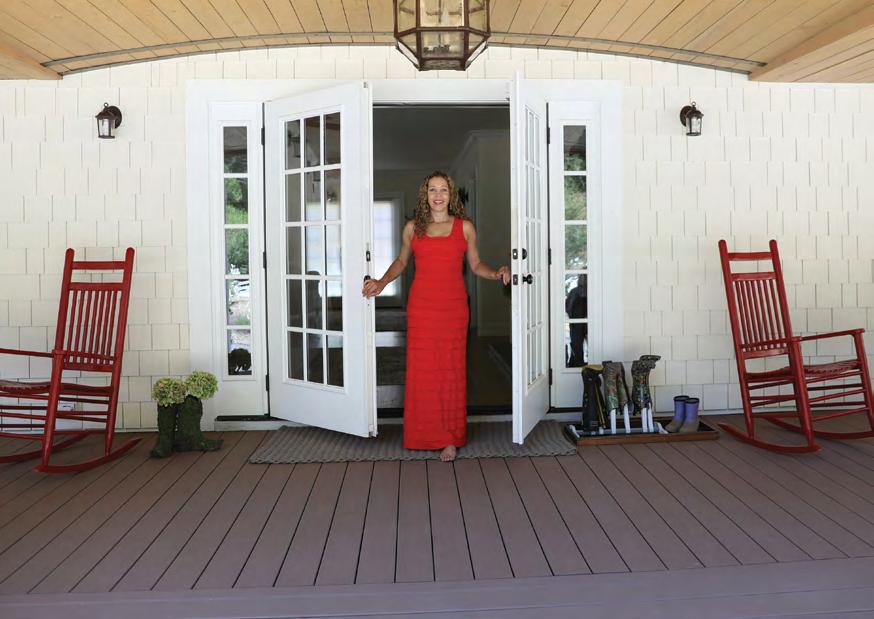
“My mission is to inspire, entertain, and have fun with you—while always setting you up for success.”
Karen Crouse
For a recent dinner where I was pouring my Mount Veeder Magic Vineyards Cabernet Sauvignon, I added vineyard photos onto each napkin ring—all different. I intended to give guests a sense of where the wine came from. With each pour, the photos invited conversation and connection.
Of all the little touches I add to a table, this one leaves the most lasting impression. It's easy, inexpensive, and works beautifully for any celebration. I've used everything from photos of the guest of honor through the years, travel moments, meaningful places shared, and even a few that made us laugh out loud. Every table tells its own story. You don't need a big budget to make guests feel at home—just a photo and a bit of heart.
Makes 10 Rings
SUPPLIES NEEDED:
• 10 printed photos (2” x 2”)
• Sharp scissors or a paper trimmer
• Glue dots or double-sided tape (I like UGlu brand)
• Napkin rings (plain, smooth wood, metal, or stone, 2”–2.5” diameter)
TIP: Use matte or semi-gloss paper to reduce glare
INSTRUCTIONS:
Choose Your Photos
Select meaningful images—travel memories, images of the guest of honor, or milestone moments. Consider a visual theme —black and white, sepia tones, or garden-inspired— all create a beautiful effect.
Trim to Size
Cut photos down to 2x2 inches wide. Print at home or order from a photo service. Clean edges keep the look polished.
Attach to Napkin Rings
Test one photo first to be sure you're happy with the placement. Then, use glue dots or tape to affix the photo to the ring, centered or slightly off-center. Press firmly for a few seconds, and voila!
Set the Table
Slide the napkins through and place them at each seat. Let the photos do the rest. I like to invite guests to take their photo home as a keepsake.


The Lincoln at Ace & Vine showcases a new, unexpected side to Napa Valley with their robust entertainment and gaming.
“Napa is known for world-class wine and fine dining, but sometimes you just want a spot that feels fun, social, and a little unexpected,” shared Michael LeBlanc, proprietor at The Lincoln at Ace & Vine. This is precisely why LeBlanc opened The Lincoln and Ace & Vine, to show visitors and locals alike, a different side of the Valley and to “fill the gap in the Napa Valley for a place with lively entertainment, gaming activities and a come-as-you-are vibe.”
The Lincoln has quickly become the heart of downtown Napa’s nightlife in just two short summers, thanks to its unique blend of gaming and nightly events. This spring, The Lincoln took things a step further, deepening its partnerships and strengthening ties with its sister card room, Ace & Vine. Whether guests are in the mood for a round of poker, blackjack, or baccarat, there’s always action in the cardroom, and the rotating lineup of live events like salsa nights with its partner Banda La Solteca and silent discos keeps the energy high even beyond the game room. “‘Come for the


cards, stay for the experience’ is our unofficial slogan,” said LeBlanc.
That experience includes comfort food favorites and signature cocktails branded as their “high stakes sips” to help refuel revelers in between their chosen entertainment. One of The Lincoln at Ace & Vines’ signature dishes is the Hot Streak Quesadilla, which evolved from a latenight staff meal to a guest favorite. “It’s comfort food with a little flair,” explained LeBlanc, who added that the dish was created when their talented culinary team was playing around with spice blends and grilled veggies after service. “The flavor just hit—smoky, cheesy, with a little kick,” said LeBlanc. The sauce may have taken a
few weeks to perfect, but now it’s got the right balance of heat and tang. “It was such a favorite among the team that we knew it had to go on the menu.”
Another defining feature of The Lincoln at Ace & Vine is its expansive outdoor entertaining space, including a newly renovated patio green that blends the energy of a card room with the laid-back fun of lawn games. Here, camaraderie takes center stage as guests go head-to-head in ping pong, cornhole, Connect Four, beer pong, Jenga, and single-hole mini putt.
For those looking to unwind between rounds, the lush terrace overlooking the Napa River offers a quieter retreat with fire pits perfect for year-round conversation and connection. Whether a casual night out with friends or a private event, these two dynamic spaces can be combined to host up to 400 guests for full buyouts.
“The Lincoln at Ace & Vine is a vibrant destination where locals and visitors can come together for all things gaming, with late-night offerings that keep the energy going,” LeBlanc emphasized.
www.thelincolnnapa.com www.aceandvine.com


BY LAYNE RANDOLPH

California’s wine story began with a humble grape: Mission. Often overlooked or dismissed today, it was planted, pruned, and poured at 21 Spanish missions that stretched from San Diego to Sonoma beginning in 1769. The Spanish crown and Catholic Church established the California missions to convert Indigenous peoples to Christianity and secure colonial control. “Mission” wine was the foundation for the state’s $40 billion wine industry.
The Mission grape, a dark red variety of Vitis Vinifera also known as Criolla Chica in Argentina and Pais in Chile, is believed to descend from Listán Prieto from Spain’s Canary Islands. It was brought to the Americas by Spanish missionaries, and its journey to North America began in Mexico and went northward as the Spanish crown sought to colonize Alta California in the 18th century.
Franciscan missionaries, led by Father Junipero Serra – often called the father of American wine—needed wine to celebrate Mass; they needed dependable, easy-to-grow, and prolific grapes. The Mission grape fit the bill. It wasn’t the most nuanced or aromatic varietal, but it was hearty. It thrived in poor soil, endured drought, and ripened reliably.
After Mexico secularized the missions in the 1830s, their vineyards fell into disrepair.
The Gold Rush brought European immigrants with their unique skills and varieties, followed by phylloxera and changing tastes, which pushed Mission wine to the margins. By the 20th century, it was often relegated to sweet, fortified styles of little acclaim.
Yet there are producers today like Angeleno Wine Company and Galleano Winery, which have experimented with the Mission grape, embracing its history and turning it into modern-day wine. Its mark through the state is shown on what is now known as the Mission Trail, the line of what were once Spanish missions, many no longer accessible or functioning as churches, but others still standing as reminders of California’s past. Together, these Mission Trail stops mark the origin of a culture shaped by migration, devotion, and the legacy of the Mission grape.
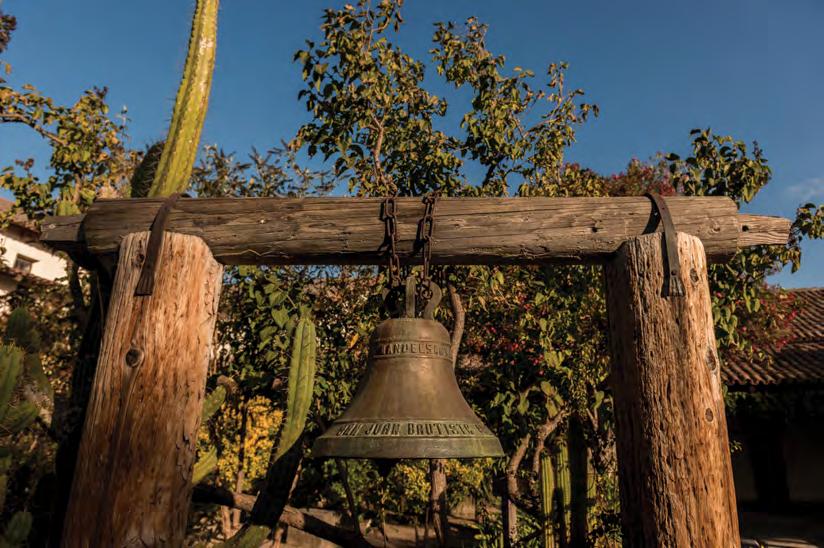


BEGINNING of the MISSION TRAIL California’s wine history starts at the southern edge of the state. The Franciscan friars planted the first Mission grapes at Mission San Diego de Alcalá, initiating what would become not only a network of religious outposts but a living wine route. In the arid, coastal landscape, wine was a religious necessity—something needed for Catholic Mass.
Further north, at Mission San Gabriel Arcángel, the region’s early viticultural ambitions took deeper root. Located just east of today’s Los Angeles, this mission became one of the first major sites of wine production in Alta California. At its peak, it
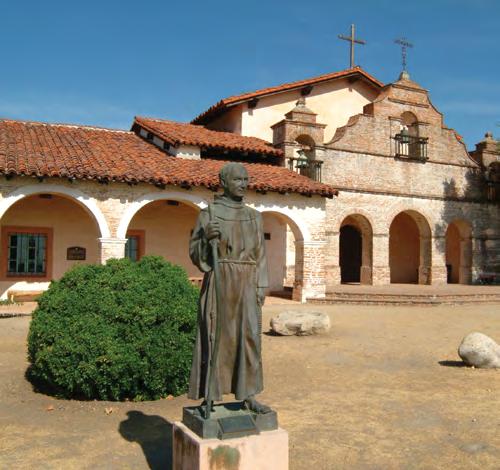

produced thousands of gallons annually— a staggering amount for the late 18th century. While little remains of those early vineyards, the legacy lingers in unexpected corners of LA’s urban sprawl.
One of the most compelling modern echoes can be found at Angeleno Wine Company, a small winery tucked into a warehouse near downtown. Sourcing fruit from what is believed to be a 249-year-old Mission vine known as the Ramona vine in San Bernardino County. With this fruit, they craft Angelica, a sweet, fortified wine some consider the oldest in California. In Northern Sonoma, Trentadue Winery in Alexander Valley continues the Mission legacy with its own Angelica, drawing on a tradition it first bottled in the 1970s.
To the south, Galleano Winery in Riverside County tells a different chapter of the story. Founded in 1927, Galleano still farms some of the oldest Mission grape vineyards in the state. Their fortified Angelica is made in homage to 19th-century sacramental wines: deep and sweet.
Even the coastal hills of Orange County offer their own reflection of Mission heritage. Nearby, the Mission San Juan Capistrano is one of the most picturesque missions on the trail. And at Mission San Luis Rey de Francia in Oceanside, visitors can find preserved winemaking tools—physical artifacts of a time when wine was made not for connoisseurship, but for ceremony and survival.
If Southern California was the birthplace of mission wine, the Central Coast was its proving ground. In this middle stretch of California, the Mission grape found its rhythm, thriving in drought, ripening under the watchful eye of friars and farmers alike.
In Monterey County, Mission San Antonio de Padua remains one of the least visited missions on the trail. Remote and hauntingly beautiful, it offers a glimpse of what early Alta California might have felt like—quiet, vast, and vine-laced. Beyond its borders, the Paso Robles region carries that spirit into the present day. Here, a new generation of vintners embraces dry farming, biodynamic methods, and minimal intervention—echoes of the austere, hands-on practices that once defined mission winemaking.
Wineries like Tablas Creek and Alta Colina operate with an almost monastic devotion to the land, choosing patience over manipulation and crafting wines that reflect the terroir. This is a fitting evolution in a region that once made wine out of necessity and now does so with focused intention.
To the north, Mission San Miguel Arcángel still houses its original wine cellar, its stone walls cool and dark beneath the midday heat. It’s not hard to imagine barrels lined up along the dirt floor, tended by novices and Indigenous workers in silence. That cellar remains one of the most tangible links to early California winemaking, a sacred architectural relic of oenological perseverance.
Near Mission San Luis Obispo de Tolosa, cool-climate wines now dominate, especially in the Edna Valley and Arroyo Grande. Producers like biodynamic producer Scar of the Sea pursue purity through restraint and craft elegant wines from grapes grown in ocean air, shaped by chalky soils.
And east of the coast, the Mission Nuestra Señora de la Soledad, long weathered by wind and time, lies near the Arroyo Seco AVA. Finally, the San Benito AVA holds one of the most quietly powerful sites on the trail: Mission San Juan Bautista. Nearby, Eden Rift Vineyards, crafting delicate, expressive wines, sits on limestone-rich soils and maintains a heritage-focused approach to farming.
The Mission grape is no longer the main attraction in the Central Coast region. Still, its spirit endures in winemakers’ agricultural and vinicultural choices: dry-farmed vines, natural fermentations, and a willingness to let the land speak.
As El Camino Real (“The Royal Road,” the original name of the Mission Trail) continues north, the terrain opens into vineyardlaced valleys and coastal canyons, leading to one of the trail’s crown jewels: Mission Santa Barbara, known as the “Queen of the Missions.” With its twin bell towers and Spanish colonial elegance, it has long
stood as a symbol and a sentinel of early California.
Just inland, in the Santa Ynez Valley and Sta. Rita Hills, modern winemakers are crafting wines that feel like natural extensions of this legacy. Many local wine producers embrace the land and its layered past, experimenting with heritage varietals and minimal intervention techniques that


echo the simplicity of early mission winemaking. Nearby, at Mission La Purísima Concepción, a fully restored site near Lompoc, relics of 19th-century wine production remain on display.
To the north, Santa Maria Valley stands apart—never home to a mission yet indelibly shaped by their influence. It’s here that Foxen Vineyard & Winery has paid one of the most heartfelt tributes to the Mission grape, producing small-batch, port-style wines that nod to the sweetness once sipped from chalices in California’s earliest churches.
The Mission grape may never headline tasting menus or command record prices, but its role in California wine is foundational.
As the trail winds farther, the missions grow fewer, but their impact deepens. Mission Santa Clara de Asís lies in the heart of what is now Silicon Valley—land more associated with microchips than grapes. Nearby, Mission San José helped shape the Livermore Valley, one of the oldest wine regions in the state.
And finally, the trail ends—geographically and symbolically—at Mission San Francisco Solano in Sonoma. Established in 1823, it was the last of the 21 missions and the only one founded under Mexican rule. But it also marked the beginning of California’s commercial wine industry. Today, steps away from Mission San Francisco Solano, Sonoma’s Scribe Winery makes two versions of Mission wine, still and sparkling, from mission grapevines on the Scribe Estate. Even the nearby Reverdito Wines is part of this living history, working with agricultural historians to produce small-lot Mission bottlings that trace a path from past to present.
The Mission grape may never headline tasting menus or command record prices, but its role in California wine is foundational. It endured through colonization, phylloxera, hardship, and obscurity, kept alive by those who saw value in its history as much as its fruit. It symbolizes California’s past, reminding us that California wine began with something simple and sacred. The Mission grape lives on.
BY MELISSA VOGT

Few places in Napa Valley evoke the same reverence as Oakville. This narrow, sun-drenched corridor between the Mayacamas and Vaca Mountains has become synonymous with Napa’s finest Cabernet Sauvignon—deeply structured wines that marry power with poise. Home to generational estates, pioneering winemakers, and some of the most coveted vineyards in the world, Oakville is the epicenter of Napa Valley’s Cabernet culture.


Oakville’s viticultural story began in the mid-1800s, when H.W. Crabb planted To Kalon—arguably one of Napa Valley’s most famous vineyard sites. His efforts laid the groundwork for a flourishing wine community that was nearly wiped out by Prohibition. But in the decades that followed, visionaries like Robert Mondavi resurrected Oakville’s potential. When the Oakville AVA was officially recognized in 1993, it merely confirmed what winemakers and collectors already knew: this was sacred ground for Cabernet Sauvignon.
Heitz Cellar was one of the early believers in the Oakville AVA. “Heitz Cellar has been working with Oakville fruit, namely Martha’s Vineyard, since 1965 and produced the first single vineyard wine in Napa Valley from this historic vineyard in 1966,” says Brittany Sherwood, Director of Winemaking
Within the Oakville AVA borders lies a confluence of climate and soil that is nothing short of extraordinary. Situated in the center of Napa Valley, Oakville enjoys long, warm days balanced by cool marine air that drifts inland from the San Pablo Bay each afternoon. This diurnal shift allows grapes—especially Cabernet Sauvignon—to ripen fully while retaining critical acidity.
The soils are equally dynamic. “Opus One’s vineyards stretch across a sequence of alluvial fans that emerge from the western foothills and sweep northeast toward the Napa River,” explained Silacci, Winemaker at Opus One. “As the terrain descends, gravel content decreases, giving way to increasing amounts of clay, sand, and silt.” This variance of soil allows

at Heitz Cellar. “It was abundantly clear to Joe Heitz in the 1960s that this vineyard was producing something extraordinary.”
The AVA’s prestige grew with the rise of modern Napa Valley. Groth Vineyards & Winery earned Napa’s first 100-point score for an Oakville-grown Cabernet Sauvignon, and estates like Silver Oak and Far Niente earned critical acclaim. As time went on, Robert Mondavi’s collaborations with international legends and Far Niente’s restoration of a historic 19th-century winery only deepened the region’s influence. Today, Oakville is home to over 70 vineyards and some of the most recognized names in the world of fine wine.
for wines with both plush texture and firm structure.
At the western edge of the AVA lies Martha’s Vineyard, the site of one of Oakville’s most iconic expressions. “Martha’s Vineyard is located on the western side of Oakville at the base of the Mayacamas Range. It has the benefit of both healthy, fertile soils, with great natural drainage,” said Macy Stubstad, Director of Vineyard Operations for Lawrence Wine Estates, the larger portfolio brand under which Heitz Cellar operates. “The fruit benefits from gentle morning light as it faces the eastern Vaca ridge in Napa, and has the afternoon protection of
the Mayacamas, allowing the fruit to retain its freshness and natural acidity through maturation.”
These variations in elevation, drainage, and composition provide winemakers with a diverse palette to work, resulting in wines that are as nuanced as they are powerful. “The subtleties of the appellation from north to south and from east to west paint a rich diversity in the wines over time,” Silacci says. It’s this sense of place that continues to define Oakville wines. From the velvety textures of Far Niente’s estategrown Cabernet to the age-worthy structure of Heitz’s Martha’s Vineyard bottling, terroir speaks in every glass.
Cabernet Sauvignon is undoubtedly the king of Oakville, but it doesn’t rule alone. Merlot, Cabernet Franc, Petit Verdot, and Malbec frequently play supporting roles, while Sauvignon Blanc and Chardonnay are coveted white wine offerings. Winemaking leans toward restrained power, favoring elegance over excess. Whether aged in new
Oakville is a measuring stick by which all other Napa Cabernet is judged. Its wines are rich but refined, structured yet seductive. Here, legacy and innovation coexist.
French oak for added polish or crafted with minimal intervention to let the vineyard’s character shine through, Oakville winemakers share a common goal: to capture the essence of their site.
“We don’t leave our footprints in the vineyard, nor do we leave our fingerprints on the glass,” said Silacci. Oakville vintners, he adds, are also grounded in a sense of stewardship. “Agroecology and regenerative farming are ways we are going back in
time to care for the environment and areas outside of the vineyard footprint,” Silacci said. “They are attempts to improve grape and wine quality, and to leave the place in better condition than we found it.”
At Heitz Cellar, commitment to the land is matched by a deep understanding of what makes Oakville unique. “Oakville as a whole is incredibly diverse, as it spans east to west across the valley with different exposures, daylight and sun intensity hours, and soil types,” said Stubstad. “Each of these variables requires different farming techniques. Each farming decision should lend itself to expressing Oakville’s famed terroir into the winemaking.”
That reverence for place—and for passing it on—is a hallmark of the AVA’s wines.
Robert Mondavi Winery:
A Napa Pioneer Founded in 1966, Robert Mondavi Winery is more than just a historic estate—it’s the birthplace of modern Napa Valley. With his namesake winery located in the heart of Oakville—currently undergoing



a highly anticipated winery renovation— Mondavi elevated California wine onto the global stage. His development of Fumé Blanc and commitment to vineyard-designate Cabernet Sauvignon, particularly from the famed To Kalon Vineyard, set a benchmark for quality that still guides the region today.
Realized in Oakville
Founded as a groundbreaking partnership between Robert Mondavi and Baron Philippe de Rothschild, Opus One seamlessly blends Bordeaux tradition with the unique expression of Napa Valley. Its elegant Cabernet and architecturally striking estate have made it a symbol of
international luxury. With each vintage, Opus One affirms Oakville’s place on the world stage of fine wine.
Originally built in 1885, the historic Far Niente was resurrected in the late 1970s and quickly became one of Oakville’s crown jewels. The stunning stone winery, nestled at the base of the Mayacamas Mountains, crafts wines of richness and finesse. Known for its estate-grown Cabernet Sauvignon and Chardonnay, Far Niente strikes a balance between historical reverence and modern precision, producing wines that are both luxurious and age-worthy.
While Heitz Cellar is based in St. Helena, its legendary Martha’s Vineyard lies squarely in Oakville—and it’s one of the most influential single-vineyard wines in Napa history. Since its first vintage in 1966, Martha’s Vineyard has showcased a distinctive, minty eucalyptus signature that has become iconic. “Our mission is to continue producing this Cabernet Sauvignon in its timeless, age-worthy style and share our passion for producing this wine with guests and collectors,” says Sherwood. This vineyard helped solidify the concept of terroir-driven Cabernet in California and remains a benchmark for the varietal.
Since 1972, Silver Oak has been synonymous with American oak-aged Cabernet
Sauvignon. Its Oakville estate is not only a visual stunner—with LEED-certified architecture and sustainable farming—but also a leader in accessible, age-worthy wines that resonate with collectors and casual drinkers alike. Silver Oak’s commitment to consistency and hospitality makes it a must-visit for anyone exploring Oakville’s wine culture.
Oakville is a measuring stick by which all other Napa Cabernet is judged. Its wines are rich but refined, structured yet seductive. Here, legacy and innovation coexist, and vineyard blocks carry global reputations. As Silacci puts it, “We are all proud of the leading wineries in the AVA. They lift us all to greater heights.” Whether you’re a collector chasing cult Cabernets or a traveler seeking unforgettable wine country experiences, Oakville offers a window into the soul of Napa Valley.
Napa’s most famous cult wine, Screaming Eagle’s micro-production Cabernet commands astronomical prices and critical acclaim. Its elusive status and vineyard precision have helped fuel the mystique around Oakville terroir.
Set in the hills above Oakville, Harlan Estate redefined luxury wine in Napa. Its Bordeaux-style blend is powerful, plush, and age-worthy, earning it frequent comparisons to the world’s first growths.
Tucked into Oakville’s eastern hillside, Dalla Valle has quietly built a cult following for its dense, expressive Cabernet Sauvignon and world-class Cabernet Franc. With a legacy of meticulous farming and limited production, the wines are prized for their structure, elegance, and aging potential.

PlumpJack Winery
reflects on settling into their Oakville estate and the most significant milestones since debuting their first wine in 1995.
BY JILLIAN DARA | PHOTO COURTESY OF PLUMPJACK WINERY
It’s been 30 years since PlumpJack Winery produced its first vintage of Oakville Estate Cabernet Sauvignon, and according to General Manager John Conover, “It went by in a blink.” Though much has changed with respect to farming practices, winemaking, and technology, Conover explained that the core fundamentals of growing, making, and enjoying wine from this land haven’t changed.
One of the most significant evolutions is how streamlined PlumpJack’s portfolio has become. “We made so many varietals in the early days,” said Conover. “Over the first few years, we focused intently on narrowing our wines down to the few we believed best showcased the essence of our Oakville estate.”
After exploring their estate’s full potential, Conover discovered the wines in Oakville were more reminiscent of Burgundy than of the Bordeaux appellation regarding diversity. “From structured hillside wines to soft, luscious flavors from the valley floor, the way these vineyards differentiate themselves is remarkable,” shared Conover. Yet, one of the bestsellers is the Oakville Cabernet Sauvignon — an expressive wine that consistently showcases flavors of black
and red fruit with firm tannins that are approachable upon release.
“This was apparent from the first vintage of the 1995 PlumpJack Estate and Reserve Cabernet Sauvignons, but since head winemaker, Aaron Miller's arrival in August 2012, he has done a tremendous amount of work in the vineyards to nurture out the very best our terroir has to offer.”
Another milestone in the PlumpJack timeline was its shift to screw tops — a personal undertaking of Conover’s, who explained that as not only vintners but restaurateurs, retailers and consumers, PlumpJack discovered a large number of wines, globally, were being affected by cork taint (TCA). His team began a journey to address the issue through the exploration of alternative closures and felt the screw cap closure had the most promise for eliminating TCA.
Conover admitted the change posed potential risks. He explained that screw caps were embraced by winemakers but despised by wine marketers, so they partnered with UC Davis to do an independent study on screw cap closures versus cork-finished closures beginning with the 1997 vintage—and it continues today. To mitigate the perceived stigma, PlumpJack
launched a “grand experiment” with its customers. The winery offered wines in two-packs: one cork-finished bottle and one with a screw cap-finish, or six-packs with three of each. “We leaned in even further by doing this with not our least expensive wines, but our most expensive: the PlumpJack Oakville Reserve Cabernet Sauvignon,” said Conover. The experiment worked, and as the first to take the risk, Conover feels PlumpJack is in a prime position 30 years later.
In the midst of their 30th anniversary celebration, PlumpJack encourages guests to swing by and let the wines speak for themselves; whether tasting through the winery’s current releases on their verdant patio, exploring their library selections as part of their collector’s tasting or simply dropping in — no reservations required — for a casual offering where guests can choose their own adventure with one of their bottles. www.plumpjackwinery.com




BY LAYNE RANDOLPH



For years, Mendoza was defined by what was in the glass: bold Malbec, poured beside sizzling steaks, enjoyed under a wide-open sky. That story still rings true—but today, Mendoza is being refined, elevated, and expressed through a new generation of artisans, vintners, chefs, and distillers who understand that true sophistication lies in innovation and heritage.
Mendoza is perched at the foothills of the Andes, where vineyards climb altitudes ranging from 2,000 to over 5,000 feet above sea level. The diurnal shift—hot days, cold nights—slows ripening and builds complexity. Add a dry climate, intense sunlight, and poor alluvial soils, and you get the building blocks of powerful yet nuanced wines.
Three major subregions anchor the scene: Luján de Cuyo, Maipú, and the increasingly dominant Uco Valley. In 1993, Luján de Cuyo became the first region in Argentina to receive a formal AOC for Malbec—a milestone that helped elevate Mendoza’s wine industry on the world stage. Luján is Mendoza’s historic heartland, home to legacy producers like Bodega Catena Zapata and Bodega Terrazas de los Andes, crafting plush Malbecs.
Uco Valley is the highest-altitude wine region in Mendoza Province, with vineyards ranging from 900 to 1,500 meters (3,000 to 5,000 feet) above sea level. The cooler climate and extended growing season create ideal conditions for crafting refined, complex wines. While Malbec remains a flagship varietal, the region also excels with Cabernet Franc and Chardonnay, offering elegant expressions shaped by altitude and terroir. This is where you’ll find Tuscany’s Alberto Antonini’s Altos Las Hormigas and

the renowned Clos de la Siete, owned by French investors, including winemaker Michel Rolland.
California winemaker Paul Hobbs’ arrival in Mendoza in the late 1980s marked a pivotal moment in the history of Malbec. His wine expertise helped elevate it into one of the world’s most captivating red wines—graceful, robust, and a true reflection of its origin. His work with Viña Cobos and his emphasis on high-altitude vineyards in Luján de Cuyo and the Uco Valley opened up a new realm of possibilities for Argentine wine.
Maipú boasts some of Argentina’s oldest vines and is known for its rural character and deep agricultural roots. The landscape is dotted with vineyards and olive groves, and its lower elevation compared to other Mendoza regions results in a warmer, sundrenched climate that produces expressive, fruit-forward wines—particularly Malbec, Cabernet Sauvignon, and Tempranillo— with fuller body and ripe character. Many wineries in this region have been familyowned for generations, preserving traditional techniques while embracing modern advancements.
While Malbec remains the flagship, Mendoza’s winemakers are expanding the repertoire. White wines—particularly Torrontés —are gaining attention for their floral lift and mineral precision.
Few names have done more to elevate Argentine wine than Susana Balbo. The country’s first female enologist, Balbo defied expectations to build a lasting legacy. Her recent induction into the Decanter Hall of Fame—the first Latin American woman to receive the honor—celebrates her tremendous influence in Argentina and beyond.
Balbo’s Torrontés shines bright. Dubbed the “Queen of Torrontés,” she’s transformed the grape into a refined expression: crisp, aromatic, and structured. Her portfolio ranges from classic Malbec to concreteaged Torrontés, expanding into natural, low, and no-alcohol wines that challenge convention while honoring terroir.
Today, alongside her daughter Ana Lovaglio, she leads Susana Balbo Wines and the immersive SB Winemaker’s House & Spa Suites—a fusion of hospitality, wellness, and artistic vision. The estate offers immersive wine blending workshops, ultra-premium tastings, and custom spa rituals. A menu of bathtub turndowns incorporates local herbs and chakra-balancing aromatherapy blends prepared nightly in ensuite, heated,


concrete egg-shaped tubs that infuse the water with lavender, chamomile, and eucalyptus, maintaining warmth for hours while elevating the senses. The ritual reflects Mendoza’s magic and the estate’s commitment to beauty and local tradition.
In the Uco Valley’s Los Chacayes IG, Corazón del Sol channels the energy of the mountains into Rhône-style wines. Winemaker Luciano Bastias crafts Rhônestyle wines with an Argentine twist. The vineyard’s stony soils, high elevation, and
Luján de Cuyo. One of its standout labels is Tomero, a range of single-varietal wines made from grapes grown at Finca Tomero in Los Árboles, Tunuyán, in the Uco Valley. The winery combines family tradition with thoughtful innovation, using gravity-flow winemaking and avoiding mechanical pumps to preserve the purity and integrity of the wine.
Achaval Ferrer, also based in Luján de Cuyo, is renowned for its high-altitude Malbecs and a minimalist, terroir-driven approach. The winery focuses on producing bold yet elegant wines from low-yield, old-vine vineyards—some of which are ungrafted and date back to the early 1900s— capturing the true essence of Mendoza’s most exceptional terroirs.
At Domaine Elena de Mendoza (EdeM), the Catena family has launched

constant breezes create ideal conditions for Syrah, Grenache, and Mourvèdre, which Bastias vinifies with minimal intervention and aging in neutral vessels.
“We’re not just making Argentine wine,” Bastias said. “We’re making mountain wine.” Amphorae, concrete eggs, and native yeasts all play a role. Tasting through their estate blends, there’s a sense of clarity and focus on site over style. Bastias’s Syrah pulses with wild herbs and black pepper; his Grenache is savory and floral, with an alpine edge that reflects its setting.
Bodega Vistalba, founded in 2003 by Carlos Pulenta, the third generation of a respected winemaking family, is located in

a 0.0% ABV sparkling rosé made with rose petals—a striking example of Mendoza’s new era of creativity.
Also in Uco Valley, The Vines Resort & Spa is situated on a 1,500-acre estate, blending contemporary comfort with a deep immersion in the craft of wine. Its 21 villas offer expansive indoor and outdoor living spaces, spa-inspired bathrooms, and private decks that frame the Andes in cinematic light. Investors can purchase vineyard plots to cultivate their own brand of wine, and guests can participate in culinary workshops that teach the art of making empanadas and grilling gaucho-style. Off-property, the
experience continues with 4x4 excursions into the mountains. It’s an adventure, a luxury, and a wine education experience rolled into one.
Sergio Roggerone’s home in the rural area of Chachingo (Maipú) doubles as his studio, La Alboroza, a wildly creative, otherworldly enclave where art, architecture, and nature converge. It is one of the last places where the plumeria, a sacred feather technique once used in Indigenous ceremonial art, is practiced. Roggerone creates layered works combining antique manuscripts, pigment, parchment, and gold. His Tree of Life hangs at the entrance of SB Winemaker’s Spa and Suites.
Even Mendoza’s spirits scene is infused with the culture of craftsmanship. At Williams Casanegra, brothers Gabriel and Cristian Williams are making the world’s first Andes Single Malt whisky with glacial meltwater and locally sourced barley. The whisky is distilled at altitude and aged in custom oak barrels, some of which were previously used to age wine. The distillery’s tasting room feels like an elegant salon, filled with hand-selected antiques, heirloom textiles, and objets d’art collected from around the world. The whisky is elegant, complex, and unmistakably place-driven.
Once known chiefly for hearty asados and robust red wines, Mendoza now boasts a broader palate. Fire-cooked meats share the table with vegetable-forward cuisine. Hornero Restaurant at La Morada Lodge is a standout example of how Mendoza’s cuisine has grown without losing its roots. Located in the heart of Finca Los Arbolitos, a nearly 300-hectare vineyard in Los Chacayes, El Hornero’s Chef Edward Holloway cooks dishes like woodfired empanadas with braised goat, goat cheese, and roasted tomato, while sommelier Andrés Rosberg creatively pairs dishes with surprising libations from the restaurant’s extensive wine and spirits collection.
At SB Winemakers’ La VidA restaurant, meals may begin with Torrontés and end with Malbec, but nothing else is predictable. Chef Flavia Amad’s seven-course tasting menu weaves a tapestry of flavors— grilled peaches with goat cheese foam, beetroot served in five ways, and a finale of red wine–poached pears. Each course
arrives with its narrative, paired with Susana Balbo’s evolving portfolio: a citrusdriven Torrontés aged in concrete, a classic Malbec with a modern, restrained profile. Chef Flavia’s other outstanding restaurant–Osadía de Crear, located at Susana Balbo Winery—has earned a Green Michelin Star.
Famous for his Siete Fuegos fire-based cooking, Francis Mallmann has two restaurants in Mendoza, including the 1884 Restaurant listed in the Michelin Guide. The other is the on-site restaurant at The Vines Resort and Spa in Uco Valley, which showcases Mallmann’s signature techniques—charred fruits, wood-grilled meats, and slow-roasted vegetables— making each dish an event.
What began as a humble wine region is now a cradle of multidisciplinary craft. In wine, food, spirits, art, and wellness, Mendoza’s artisans are reclaiming what’s local— native grapes, ancestral techniques, glacial waters, and regional botanicals—to recraft a deeply rooted and freshly imagined sense of place. What began as bold Malbec and fire-grilled meat now hums with nuance, balance, and intentional beauty.
The Mendoza of today is defined by what it’s learned to elevate, but the evolution isn’t accidental. It’s the result of vision—of people like Susana Balbo, Sergio Roggerone, Luciano Bastias, and the
Williams brothers, who see Mendoza as a place where craftsmanship and culture create something enduring. At its core, it’s a quiet reclamation: local hands, local materials, local vision—they’re shaping their own brand of luxury. And in doing so, they’re elevating Mendoza.
FOR MORE INFORMATION www.turismo.mendoza.gov.ar



BY FRAN MILLER

Spanning 1,500 acres at the northwest tip of San Francisco, The Presidio is a national park unlike any other. A former military post transformed into a cultural and recreational destination, this swath of national parkland is now a dynamic blend of history, culture, and nature. Its historic barracks and red-roofed buildings now house restaurants, museums, and two standout hotels. Bay views, eucalyptus groves, and miles of trails make it feel far removed from the city, even though you’re steps from the Golden Gate.
Spanish colonists first established a military presence here in 1776. Over time, The Presidio served as an army base for three nations—Spain, Mexico, and the United States. Troops shipped out from here for the Civil War, World Wars I and II, Korea, and Vietnam. The barracks, airstrips, and officers’ clubs remain, but their purpose has shifted.
Now, The Presidio is managed by The Presidio Trust, a federal agency dedicated to preserving and repurposing the site. The Trust has guided its evolution carefully, striking a balance between conservation and cultural vitality. Historic buildings have been restored and reused. New construction is rare and intentional. The result is a glorious park for all to enjoy.
Visitors can get their bearings with a stop at the William Penn Mott, Jr. Presidio Visitor Center, where they’ll find maps, trail information, and an engaging overview of the area’s layered past. There’s a helpful team of rangers, plus videos and displays that explain how this land evolved from a Spanish military outpost to federal parkland.
Then, set out on foot—or bike, if wheels are preferred. Trails snake through the landscape, winding past groves, bluffs, and scenic overlooks. The Bay Area Ridge Trail offers sweeping views. The Ecology Trail leads to Inspiration Point. At the southern edge, Lover’s Lane, the oldest trail in the park, traces a historic path once used by soldiers heading into the city.


Families with kids should head straight to Outpost, a creative outdoor playground carved into a hill. Adjacent Tunnel Tops, the park’s newest addition, features meadows, picnic areas, and sweeping views of Alcatraz and the Bay Bridge. Designed by the same firm behind New York’s High Line, this elevated space seamlessly connects Crissy Field to the Main Post.
Golfers can book a tee time at the Presidio Golf Course, an 18-hole course renowned for its tree-lined fairways and tranquil, historic ambiance. For a more relaxed outing,
candid family photos. Animation buffs and casual fans alike will find something to love.
Dalida brings the bold, sun-soaked flavors of the Eastern Mediterranean to the heart of the Presidio. Run by Laura and Sayat Ozyilmaz—both veterans of Michelin-starred kitchens—the restaurant hums with energy and warmth. Diners can sit at the chef’s counter for a front-row seat to the open kitchen and the glowing Wood Stone oven that turns out what may be the Bay Area’s best pita. Puffy, blistered, and steaming inside, the chubby loaves arrive moments after baking—perfect for swiping through silky dips, herb-laced labneh, or smoked eggplant. The menu is ingredient-driven but

the Presidio Bowling Center delivers 12 vintage-style lanes, burgers and fries, and a playful escape from the fog.
Those drawn to history will want to explore the Presidio Officers’ Club, which houses the Heritage Gallery and often hosts free lectures, live music, and cultural events. Nearby, the Park Archives and Records Center offers public access to more than five million items—from architectural plans and photographs to artifacts related to the U.S. military presence in the area.
The Walt Disney Family Museum, founded by Walt’s daughter Diane Disney Miller, offers a different type of nostalgia. The galleries trace Disney’s early life, creative evolution, and lasting legacy, using interactive displays, original artwork, and
inventive, drawing on the couple’s Turkish and Israeli backgrounds. Seasonal vegetables are treated with reverence.
Craving Mexican food? Colibri, located next to the Officers’ Club, serves bold, deeply rooted dishes inspired by owner Eduardo Rallo’s upbringing. The tortillas are pressed by hand and cooked in an outdoor comal. The guacamole is made to order. Weekends bring a vibrant brunch crowd, drawn to the Huevos Benedictinos Estilo Michoacán: poached eggs, carnitas, and chipotle hollandaise over crisped corn shells.
Il Parco is Colibri’s fast-casual sibling. The focaccia-style pizza slices are light yet satisfyingly thick, topped with ingredients sourced from local farms and purveyors. There’s espresso in the morning, gelato
in the afternoon, and an all-day buzz that makes it a perfect pit stop between activities.
The Presidio is home to perhaps San Francisco’s greatest hospitality secrets: two gracious hotels, the prices of which won’t break the bank, and the views of which astound.
The Lodge at the Presidio occupies a former Montgomery Street barracks built between 1895 and 1897. The original red brick exterior remains. Inside, it’s all clean lines, soft leather, and deep armchairs that wouldn’t look out of place in a Ralph Lauren campaign. Of the 42 rooms, many face the Golden Gate. Guests gather each evening on the fire pit-heated patio
The Presidio isn’t a traditional wine country destination, yet it still manages to deliver for oenophiles. Both the Inn at the Presidio and Lodge at the Presidio offer complimentary evening wine hours—a relaxed way to sample local varietals while watching the fog roll in. Il Parco features a wine list that leans continental, with well-priced pours by the glass and a thoughtfully curated bottle selection ideal for a park picnic. Dalida pairs a great list of California and Old World wines with its Eastern Mediterranean flavors. At Colibri, the bar serves up a spirited mix of Mexican and Californian wines, along with agave-forward drinks that complement the vibrant cuisine and setting.

for complimentary evening wine, charcuterie, and conversation.
Just across the Main Parade Ground, The Inn at the Presidio offers a quieter, more intimate feel. Housed in a 1903 Georgian Revival building that once served as bachelor officers› quarters, the inn is filled with artifacts, books, and subtle nods to the past. The parlor is a cozy spot to linger, especially during wine hour. Upstairs, the suites feature fireplaces and original architectural details, including arched windows, high ceilings, and hardwood floors that have endured more than a century’s worth of footsteps. Both properties include a generous European-style breakfast and access to a porch lined with rocking chairs.
Getting There: The Presidio is easily accessible by car, bike, or public transit. There’s always ample paid parking and a free shuttle within the park.
Best Time to Visit: Fall offers clear skies and fewer crowds. Summer mornings tend to be foggy, but afternoons often clear.
Insider Tip: Grab a picnic from Il Parco, then head to one of the Bay-facing overlooks for views of the Golden Gate.
FOR MORE INFORMATION www.presido.gov

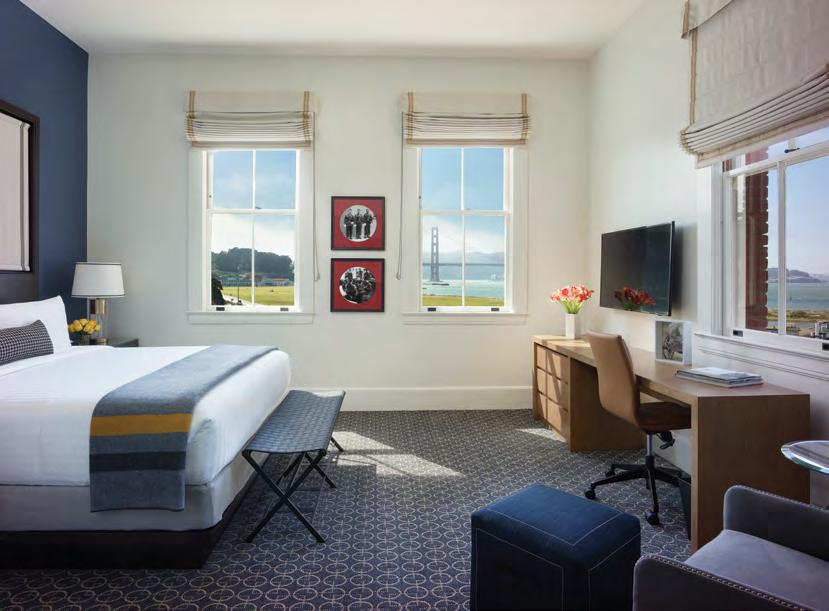
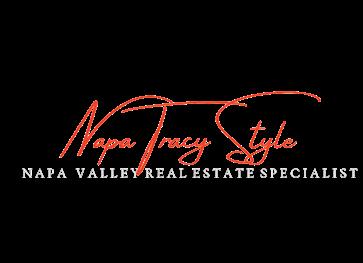
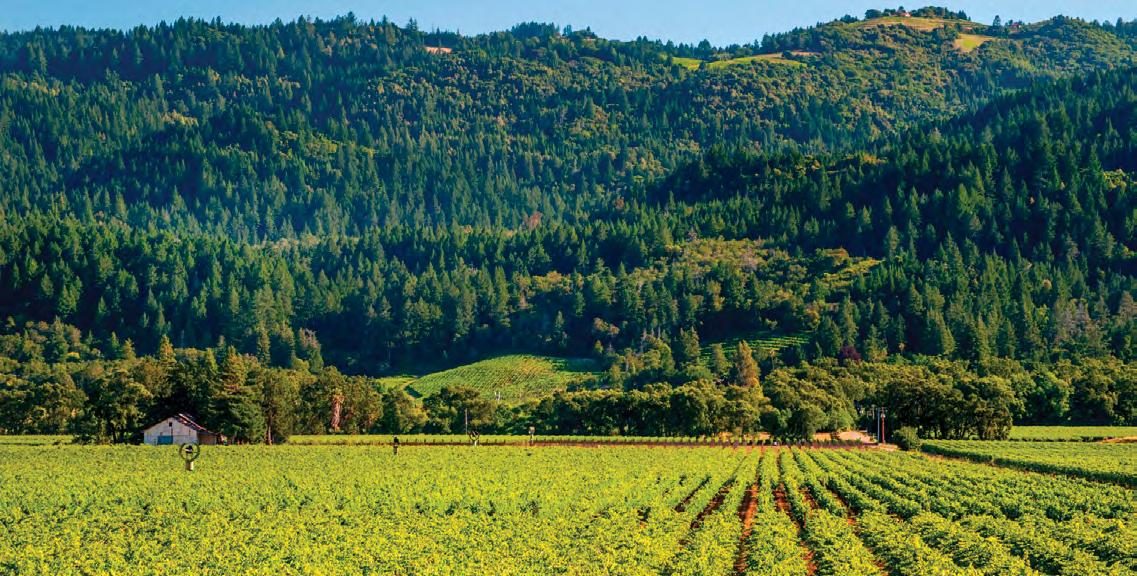
In the world of real estate, we often hear terms like “buyer’s market” and “seller’s market,” but what do they actually mean, and more importantly, what do they mean for you ? A buyer’s market, as we’re seeing now in many areas across the US, is when inventory is higher than buyer demand. In short, buyers have the upper hand. If you’re in the market for a new home in Napa Valley or preparing to sell, here’s what you need to know.
In a buyer’s market, inventory tends to sit on the market longer, which gives buyers time to weigh their options and negotiate from a stronger position. You’re more likely to find homes that check more of your boxes, and you have greater freedom negotiating price, repairs, and closing terms. Seller-paid 2-to-1 buydowns are temporary rate reductions that offer lower monthly payments in the first two years of the loan. These can be a win-win, as they are more cost-effective

for sellers than lowering the list price, and they create immediate value for buyers who may be waiting for interest rates to come down.
If you’re selling, now is not the time to sit back and hope for the best. In a buyer’s market, your home needs to shine Strategic pricing and presentation are everything. A common misconception is that pricing a home higher and being “willing to negotiate” will work in any market. Currently, homes with deferred maintenance or outdated finishes, even when priced lower, are often passed over. Buyers today are busy and typically don’t have the time or desire to take on projects. Instead, I’ve seen strong results from pricing more aggressively from the start. In fact, I’ve even negotiated multiple-offer situations in this market simply because we priced right and made the home stand out.
We’re also seeing an uptick in seller financing. By offering more favorable terms
to buyers, such as flexible interest rates or down payment options, sellers may be able to negotiate a higher purchase price or other advantageous terms.
A buyer’s market comes with both challenges and opportunities. Buyers can move with more confidence and flexibility, while sellers need to be a little more strategic and proactive. Well-priced, thoughtfully updated homes in soughtafter areas continue to sell quickly and attract serious interest. Whether you’re entering the market to buy or sell, aligning with a knowledgeable local agent who can guide you through current trends, pricing strategies, and negotiation tactics is more important than ever. Because in this market, success isn’t just about timing—it’s about strategy.
If you’re thinking about making a move, let’s talk. I’d love to help you navigate the market with confidence.
My mother was a REALTOR®, I’m a REALTOR®, and my daughter is a REALTOR®, so you could say that real estate is in our blood. Having pursued this profession for more than 17 years, my passion for the Napa Valley began in 1985, when I bought my restaurant in Calistoga. While food and beverage hospitality allowed me to share my love of our Valley with visitors and locals, I have found that helping people sell and buy real property affords me the best opportunity to get more folks to fulfill their dreams experience their own Napa Valley passions


BY LAYNE RANDOLPH | PHOTOS COURTESY

An artist, educator, and creative guide, Nancy Willis doesn’t just teach painting; she curates immersive experiences that blend fine art with the spirit of place. Whether in her spacious Napa Valley studio, a vineyard hillside, a luxury hotel, or a meadow, she invites participants into a space of curiosity, beauty, and transformation.
“I’m a practicing artist and a teacher, and I love both those things,” Nancy said. Her signature offering is private and group painting sessions tailored to each participant’s needs—no cookiecutter paint-and-sip evenings here. “One of my specialties as a teacher is to get people to overcome their fears. Most people who don’t paint regularly have a
lot of self-doubt, so I try to set everyone up for success.” Her method is immersive and nurturing. Whether painting indoors or en plein air, it’s a carefully curated setup: high-end materials, fresh flowers or still life scenes, snacks, wine (if one likes), and a calm, focused energy that puts even beginners at ease. “I do a demonstration, show people
how to mix color, how to approach the subject—and then I paint alongside them,” she explained. “They can see how I’m working and ask questions. I check in to support their progress.”
Nancy’s distinctive painting style centers around light, atmosphere, and movement. “One way to think about my work is light—it is a key element,” she said. Light plays a technical and conceptual role in her paintings, whether she’s capturing the flicker of a chandelier, the intimacy around a dinner table, or the layered tones of a landscape. “It’s about how we interpret what we see,” she added. “I always try to leave room for the viewer to have their own experience.”
She’s also a passionate traveler, regularly leading destination painting retreats to places like France, Sundance, the Hudson Valley, and luxury glamping sites, where her students reconnect with creativity more deeply. “I love France. I feel at home as an artist in France,” she shared. “And I bring that energy to my teaching, encouraging people to see their surroundings in a new way.”

Nancy’s distinctive painting style centers around light, atmosphere, and movement.


Nancy’s life experiences directly inform her painting and printmaking practices. Visit her light-filled studio in Napa, where guests find paintings of local vineyard terrain, France, the mountains of Sundance, and the northern Pacific Coast. Nancy’s works include images of small, intimate dinners often lit from the chandeliers hanging in the Redwood trees in her front yard.
Nancy’s original artwork is available through her website and studio, which will be open to the public during the Napa Valley Art Association's Open Studios event on September 20, 21, 27, and 28. Private visits are also available by appointment, an ideal opportunity to view new work and schedule a custom painting experience.
As Nancy said, “You come to Napa Valley, and you want to experience the Napa Valley. So, how would you like to do that? I give them an experience— something personal, creative, and real—and they can take a little piece of Napa home with them.” FOR MORE INFORMATION www.nancywillis.com








In a region celebrated for refinement and balance, Dr. Gundeep Sekhon has created a psychiatric practice that reflects the spirit of Napa. At Napa Soul Psychiatry, she offers highly personalized mental health and weight loss care—grounded in medical excellence, compassion, and intention.
“As a physician, I believe the mind, body, and spirit are inseparable,” said Dr. Sekhon. “Healing happens when we feel safe to be our authentic selves.”
A triple board-certified psychiatrist and Obesity Medicine expert, Dr. Sekhon combines traditional psychiatry with integrative tools like nutritional guidance, mindfulness, herbal support, and lab testing. Her boutique-style model allows for longer visits, deeper relationships, and individualized treatment plans—unconstrained by insurance limitations.
Trained in both India and the United States, Dr. Sekhon earned her medical degree at Government Medical College in Amritsar. She completed her psychiatry residency at Georgetown University Hospital and her Geriatric Psychiatry fellowship at Stanford. Her career has spanned hospitals, outpatient centers, and correctional settings—including care on death row.

Now living in Napa, she’s created a sanctuary for healing. “This isn’t about handing out diagnoses,” she said. “It’s about guiding my patients toward clarity, balance, and transformation.”
Her patients are often high-functioning adults—executives, creatives, entrepreneurs—managing anxiety, depression, trauma, ADHD, or burnout. She also works with individuals navigating weight and body image challenges with a compassionate approach. A special focus is women’s mental health. “As I navigated my own journey, I realized how underserved women are in this space,” she said. “I want to change that.”
Treatment may include nutraceuticals, lifestyle coaching, meditation, hormone and functional lab testing, psychotherapy, or medication—always used judiciously as part of a holistic strategy. “My role is part clinician, part guide,” she explained. “I help people reconnect with themselves and rebuild self-trust.”
Because her practice is out-of-network, patients benefit from more time and access— an intentional departure from today’s fragmented system. Every plan supports long-term sustainable well-being, not just symptom relief.
Dr. Sekhon’s clinical expertise is matched by lived experience. Her personal journey through infertility, divorce, and postpartum depression fuels her deep empathy. “Healing isn’t abstract for me. I’ve been there.”
She moved to Napa to slow down, breathe deeper, and raise her daughter in beauty. On weekends, you’ll find her in Allston Park, walking with her preschooler and German Shepherd—or planning her next international adventure. “Joy is part of the healing process, too,” she added.
In a valley known for curated experiences, Napa Soul Psychiatry offers a tailored, private, and transformative path to mental wellness. Dr. Sekhon’s work honors the full complexity of the people she serves—with warmth, insight, and intention.
Napa Soul Psychiatry welcomes adults ages 18+ for private, out-of-network care.










SOLBAR RESTAURANT Solbar divides its menu into light, delicate flavors to stimulate your palate and bold, savory dishes, all with ingredients that showcase the best of what’s fresh and seasonal in the Napa Valley. Enjoy outdoor dining on the sunlit Solbar patio, or the new Picobar, for dining al fresco or relaxing by the firepits overlooking the landmark pool.
755 SILVERADO TRL, CALISTOGA // 707- 226-0860 // AUBERGERESORTS.COM


HERITAGE EATS Heritage Eats offers a fast-casual, globally-inspired menu that thinks and acts locally. The popular restaurant serves up tacos, wraps, baos, rice and salad bowls made-to-order with choice of protein, toppings and sauces with unique flavor profiles from all over the world. The Dirty Fries, Papa K’s Burger and Haven Wings are local favorites.
3824 BEL AIRE PLAZA, NAPA // 707-226-3287 // WWW.HERITAGEEATS.COM




FIRST & FRANKLIN Downtown Napa’s newest Marketplace and Deli features the best of the Napa Valley. The Marketplace offers a full-service deli and a specialty Grocery Store selling local wine and craft beer. The store is filled with grab-and-go or made-to-order sandwiches, salads, and picnic side salads for you to take home or enjoy on either of their two patios.


OSHA THAI Led by renowned Chef Lalita Souksamlane, the menu highlights her award-winning flavors and showcases dishes never before tasted at her other restaurants. Sourced with ingredients grown in her own personal garden and partnering with local vendors, Osha Thai provides an authentic farm-totable experience with quintessential wine country flair.
1142 MAIN STREET, NAPA // 707-253-8880 // WWW.OSHATHAI.COM/NAPA


PIZZERIA TRA VIGNE For the past 25 years, Pizzeria Tra Vigne reigns one of St. Helena’s local treasures. Guests of all ages enjoy the pasta, pizza, or a fresh daily special to go at this vibrant, family restaurant. Their pizzas are a crowd favorite to eat in or carry out. There’s plenty of seating outdoors on the beautiful patio, complete with a bocce court, or inside with family and friends.

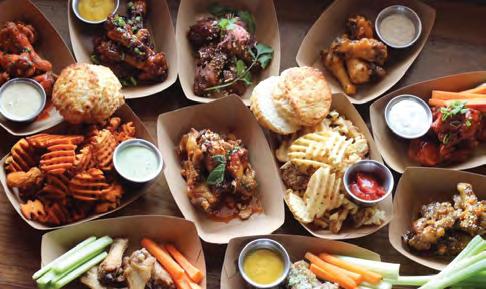
NAPA PALISADES SALOON Located in downtown Napa, Napa Palisades is a local gourmet grub pub serving American comfort food with a twist. Their full bar serves up their own Napa Palisades Beer Company house brews, over 30 local craft beers and many guest taps. They boast 16 big screen TV’s, weekend brunch and a popular happy hour.
1000 MAIN ST, NAPA // 707-492-3399 // WWW.NAPAPALISADES.COM


THE LINCOLN AT ACE & VINE This is where good times and great games come together. From Blackjack and Baccarat to lively monthly events, The Lincoln at Ace & Vine is Napa’s go-to destination for high-energy entertainment in a stylish, welcoming space with craveable bites and craft cocktails served until 2am.
505 LINCOLN AVE., NAPA // 707-699-2276 // WWW.THELINCOLNNAPA.COM

THE GRILL AT SILVERADO A one-of-a-kind Napa Valley restaurant, serving breakfast, lunch, dinner and bar appetizers, The Grill at Silverado features Wine Country Cuisine, emphasizing fresh and sustainable products. Just minutes from downtown Napa, the Grill overlooks one of the most beautiful golf courses on earth and offers a respite from the daily routine for everyone who visits.


CROCCANTE ARTISAN PIZZA Along with its made-from-scratch Detroit and Chicago-style pizzas and other delectable menu items made from locally sourced, fresh ingredients–family-owned Croccante serves up a warm, family-friendly atmosphere, earning their loyal following. NEW! Now serving breakfast and brunch Thu-Sun from 8am–1pm! Come hungry. Leave happy.
976 PEARL ST, NAPA // 707-222-5017 // WWW.CROCCANTEPIZZA.COM

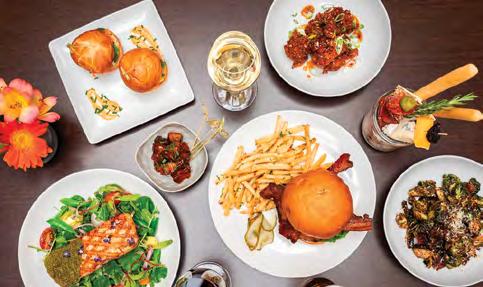
GRILLE 29 Nestled in Embassy Suites Napa Valley, Grille 29 offers a casual, friendly space ideal for a business lunch, after work drinks or dinner with the family. The tall rustic ceiling with chandeliers, sofa seating and beautiful oak bar add an old-world charm to the intimate dining room and lounge. Enjoy delightful entrees using fresh products and herbs grown from its very own garden! 1075 CALIFORNIA BLVD., NAPA // 707-320-9520


NAPA NOODLES Eiko’s sister restaurant, Napa Noodles, is an Asian Pacific Rim-style restaurant that fuses the delicious taste of Asian noodles with Napa Valley cuisine. Specialties include house-made noodles, savory soups, slow-roasted meats, seasonal salads, duck, flavorful rice dishes, Asian beers, Sake, and local wines.
